


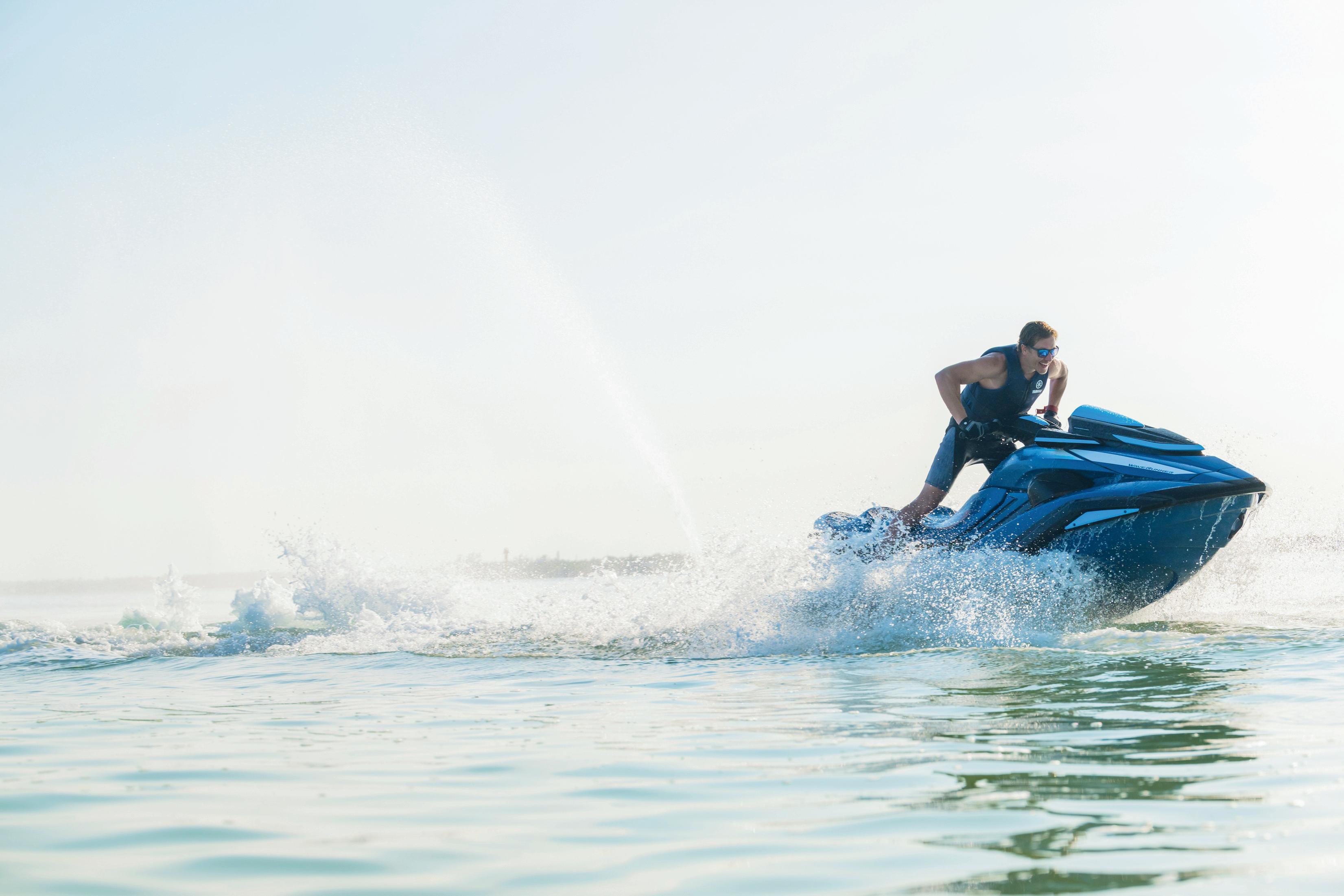



May 2024 Issue 224 NEW DEALERSHIP 23 McGlashen Avenue, Richmond www.nelsonmarine.co.nz | 03 544 0017 FREE HUNTING NEWS & THE FISHING PAPER find us in your favourite store or online at thefishingpaper.co.nz • Inshore Carnage pg 3 • Commercial Paua Sampling explained pg 7 • Opening Weekend is here pg 10 - 11 • Mainland Catch App - download now pg 14 • PongaRoar pg 15
I know they’re there; I heard them fighting a few evenings back. Back when the wind was misbehaving. There were at least four, maybe more, their battlefield just too tough for this mere mortal to enter.
I’m back. There is a different wind this time, and my mind-set is different too. I’m up for it. Up for entering the battlefield to see what I can see, and to get up close and personal with a contestant, should he be worthy of my affection.
I do everything right. Leave the vehicle far away, loop up around the block so the wind is my friend not foe. All the while I can hear that ‘it’s on’ once again.
One stag is a lazy roarer whereas another bellows with great vigour. Yet another offers his voice from above and another, he sounds like a stag crossed with a ‘cow – mooooaar.’ I sight the lazy fella with my binoculars, he’s laying down dead-centre of all the activity, a tidy 12 pointer.
My challenge, and I choose to accept it, is to close in on these stags. To join them in their well-chosen site. It will be tough, the toughest hunt of the roar thus far, but this evening I am prepared to fight for a win.
I contour towards Sleepy, its steep here, crazy steep, with loose powder-dry soil, rolling stones, dry crackly leaves. There are rock outcrops and narrow gutters and thickets of matagouri overlaid with tangles of bush lawyer.
I force myself through the thickets, squeeze along game trails, ‘spider-woman’ the outcrops but, as I get within easy shooting range, Sleepy and Vigour move into a gully out of sight. Getting onto Sleepy’ s bed is hell; he is certainly not Dopey.
Torn and bleeding I eventually sneak into position, ready to shoot into the gully where I last heard the stags fighting. It is silent.
Nothing. No roaring, no crackling vegetation, they have gone.
Did they catch a sniff of me on a back eddy? Did a sneaky hind hear me and lead them away? What did I do wrong? Was it me, or was it just a progression on the battlefield that drew my quarry away?
I wait, bummed-out after so much hard work and anticipation. It would be easy to drop my lip and skulk off having lost this game with the big boys in their most difficult of playgrounds but not today, today I am not that girl.
‘Gotcha’ – I hear a stag’s guttural grunt in the native bush above me.
Then Vigour chucks in a couple of his loud and angry roars before it all goes silent again.
Now I get it. I didn’t do anything wrong earlier; it was indeed a battlefield progression that had occurred naturally. Sleepy had had a gutsful of all the bluster from the other
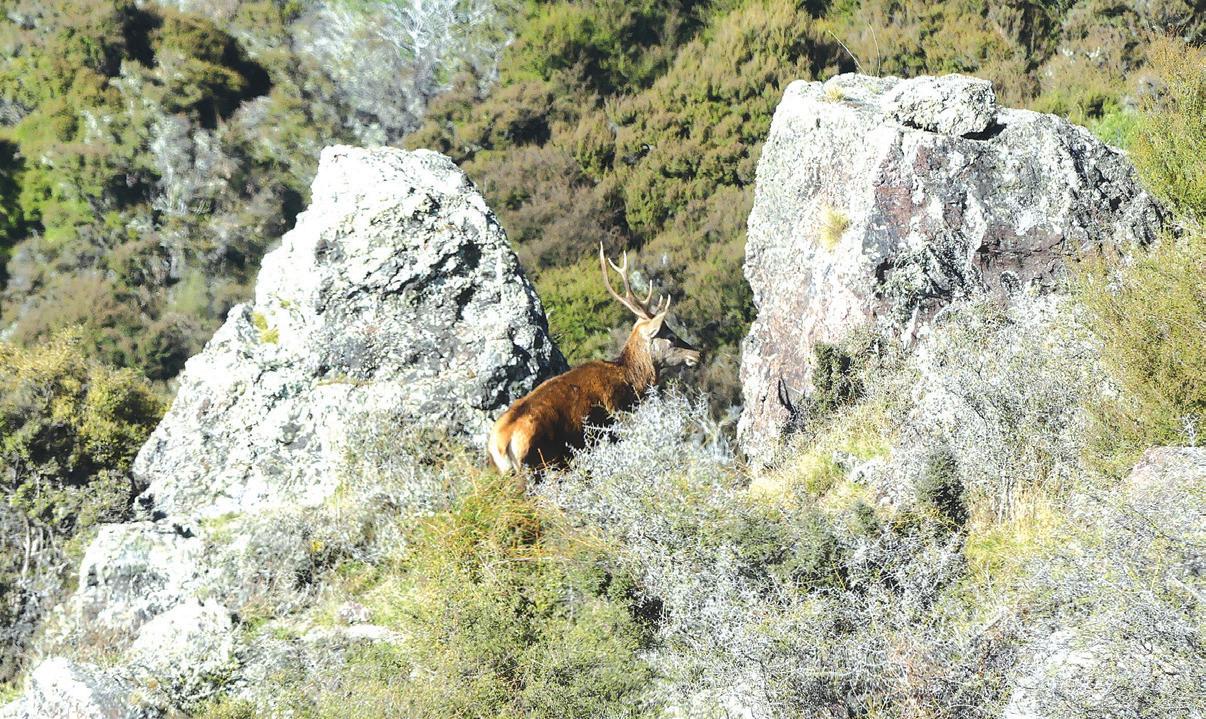
contestants so he drove his hind deep into impenetrable vegetation and hid.
Vigour rants and raves then stomps off the wrong way before Sleepy and his girl climb up through the bluffs and native, quiet and elusive. Only when they’ve made like mountain goats and found a fortress on a terrace high above do they relax their guard. Nightfall is approaching but danged if I will give up without one more attempt. I boost up the steep face until I’m confronted with a wall of vegetation so tight and interwoven no animal, not even a pig has ventured within. Stumped!
Then I notice the series of rocks, which line the crest of the skinny spur, big gnarly rocks protruding above the scrub, each one a hop, skip or jump from the next. I clamber up the face like Sir Ed and then I hop, and I skip, and I jump. I can. I will.
The last rock delivers me onto the tiniest of clearings, just 10 metres in diameter and hemmed-in by matagouri and stunted coprosma. Sleepy
is secreted by bush, just 40 metres away and oblivious of my approach. He roars regularly, comfortable now no opponent can approach his lair. I am done. I can get no closer.
I cannot roar Sleepy out – I cannot roar at all. Huge bullish bellows are not me; my trachea is not of the correct dimensions and nor are my testicles. My hind-call is ineffectual – he already has a receptive hottie. That leaves me with deception – I can do deception – I can be a timid interloper, a
spiker looking for love.
I back into that last convenient rock, sit down, wind my scope to 3x and click the safety off. Ready. I beat the droughtdried shrub beside me and grunt. Sleepy roars.
I beat that shrub again. Then again. Sleepy goes ballistic. Wait. Wait. Wait. Then beat the shrub again. Here he comes. The bushes shake and his antlers clack against tree branches. He pauses on the edge of the tangle of tight low scrub and then he’s forging through it like the proverbial freight train. I’m ready.
I’m not casual or offhand about it, nope, my heart is hammering out of control and I’m all too aware the rifle in my hands is a lightweight calibre.
The stag coming at me is a master stag, he’ll be big, and he’ll be super-charged with testosterone and adrenalin. Still, elbows on knees, rifle raised, breathing steady – I AM ready.
Head down, antlers laid back, Sleepy charges through the scrub. I let the bulging eye pass through the cross hairs, then the enormous swollen neck. I send my bullet into the triangle between the shoulders before screwing sideways on my roost. Another bullet, quick-smart, behind the elbow as Sleepy lunges past.
The setting sun tints the clouds’ bellies pink as I step eight short paces to assure myself that that really was as close as I thought. I did it, a real roar hunt, just like a real roar hunter. Sleepy will sleep forever now, but, after that close call, I won’t sleep till well after bedtime tonight.




2 THE FISHING PAPER & HUNTING NEWS - MAY 2024 FIND US AT THEFISHINGPAPER.CO.NZ AND FOLLOW ON FACEBOOK
Lost and Found Kim Swan www.scarysharp.co.nz See our website for the full range The indexed rotating clamping system has 3 angle adjustments 12˚, 20˚, 25˚ always keeping your knife in the same place The Export Series kit comes complete with x 2 clamps, x 2 combination stones (offering 4 levels of abrasion), a polished steel, tools and hardware. Made from high grade stainless steel, hygienic, easy care. NEW Export Series more compact more lightweight more precise Talk to the manufacturer toll free 0800 175 720 The constant angle knife sharpening system makes that constant angle so easy NO MORE blunt knives $590 freight & GST incl Editor: editor@thefishingpaper.co.nz Sub-Editor: Mike Brown All Enquiries: Nicola Morris 0224 503 403 admin@thefishingpaper.co.nz Printer: Inkwise Advertising Enquiries: Lynda Balfour North Island Lynda@thefishingpaper.co.nz 027 710 1510 Phil Claude South Island Phil@thefishingpaper.co.nz 021 242 4202 The Fishing Paper & Hunting News is published by Four Winds Media Ltd. All editorial copy and photographs are subject to copyright and may not be reproduced without prior written permission of the publisher. Opinions or comments expressed within this publication are not necessarily those of the staff, management or directors of Four Winds Media Ltd. Unsolicited editorial, letters, photographs will only be returned if you include a stamped self addressed envelope. https:// thefishingpaper. co.nz/
Distributors We are keen to catch up with all our distributors and get a few extra details on your experiences with the paper. The online survey can be accessed here.
The Fishing Paper & Hunting News
Inshore Carnage
Autumn is by far my favourite season for the East Coast; temperatures are mild, the sea is typically calm and the fish species are at their most abundant.
Through the autumn months, westerlies prevail, leaving beaches flat and without swell and opening up the chance for more fishing in close by. Armed with a kayak, autumn is the perfect combination to be successful just beyond the reach of a surfcasting rod.
On one blustery day the sea was flat and with a decent northwest wind , it would be comfortable to sit a few minutes off the beach and pump some tuna berley to bring in those tasty fish hanging out on the sandflats.
With the anchor firmly set, over the pot went. An oil slick flowed away from the kayak along with small morsels of tuna, hopefully soon to attract a bite.
I love to use ultra-light tackle when fishing in
gurnard had swum its way up my trail and hooked itself on one of the little cubes of tuna. These two fish were obviously waiting in the area, and it would

the shallows, so my tiny little 2 – 4kg rods were baited with some small cubes and lowered over the side.
It would be a small kahawai that hit first, gleaming in the sunlight; he was quickly sent back home.
A short wait later a beautiful red and green
take some time before any other fish found their way to my hooks. However, when they did, it would be some of the fastest fishing I had ever experienced! Out of nowhere, both rods bent over, the tips buckling, as two respectable snappers shook their heads in protest. Both went into


We have two multi calibre suppressors available in the hybrid model and this is possible because the hybrid baffle system has tight tolerances allowing the small ranges of calibre. The hybrid baffle system also lowers the risk of stray bullets and bullet strike
• The first is suitable for 22 Hornet through to 243 including, 222, 223, 22-250, 243.
• The second suppressor is suitable for 6.5 through to 30-06 including 6.5 prc, 270, 7mm-08, 284, 280, 308, 7.62 x 39 etc (not including 300 PRC or belted magnums).
• 9” in length (230mm), sits 4” forward & 5” back over the barrel (this is a “fixed” length and cannot be changed or added to)
• Weight 360 – 370grams (alu internal muzzlebrake 5-6,000 rnds)
• Colour - Black
These are our first “cleanable” suppressors – the “Hybrid” design was a pull apart suppressor that Robbie had begun creating prior to his death in 2018. In 2022, our gunsmiths took Robbie’s vision and made it a reality. The 41mm 9” suppressor is most suited for those who like to clean their suppressor.
www.GUNWORKS.co.nz
the net consecutively in short order. Next would be a familiar kick of the rod tip as a shining silver trevally circled its way up to the kayak before being quickly released back. Turning back to my left, the line ripped off my other rod as something decent charged away from the kayak. It was definitely on a mission to get far away. Solid headshakes met my rod tip as I battled
away with the unknown fish. Every time I lifted it off the bottom, it seemed like that’s where it wanted to stay, as the big fella ripped the line back down after each wind. Soon, it was clear that a rather solid snapper was behind all the commotion, along with a poor little kahawai who was being dragged around on the top hook of my ledger rig. Into the net, the big snapper went with a yippie!
Over the next hour, the fishing never let up. Gurnard, kahawai, snapper, and trevally all pounced on my baits, leaving me no time to dispatch fish. These are the days I remember fondly, and all the tough sessions make just getting out there and giving it a go worth it no matter what.
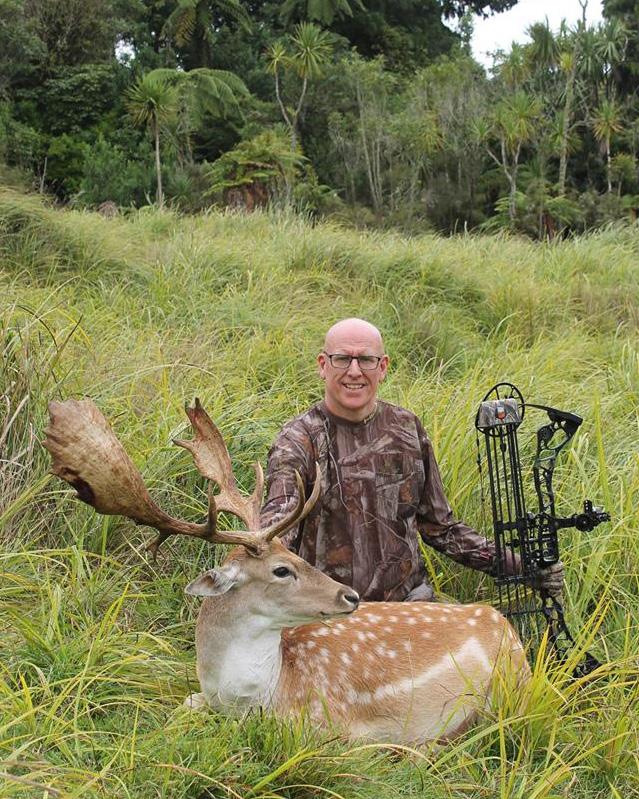








Issue 224 FIND US AT THEFISHINGPAPER.CO.NZ AND FOLLOW ON FACEBOOK 3
Unit 18, 35 Normanby Rd, Mt Eden, Auckland T. 09 636 6359 advancedarchery.co.nz Shop ONLINE Visit our new refreshed, easy to use, mobile friendly website YOU WANNA TOTALLY ESCAPE STRESS? GET A BOW & ARROW No.8 bow strings epitomise New Zealanders can-do approach to life. Designed by Advanced Archery’s Carol and Kevin Watson for our rugged conditions and made right here in New Zealand. We’ve refined the latest string building techniques, equipment, and materials we use through constant field testing to get the string quality we’re excited about. Go Kiwi with all black or choose from thousands of colour combinations with clear serving to customise it your way. Pre-stretched for zero peep rotation, with speed buttons installed and a bow tune, we’ll send your bow back to you shooting as good as new, maybe even better! Heading out on the water? P: (03) 541 8121 F: (03) 541 9325 67 Whitby Road, Wakefield 7025 W: www.wasl.co.nz We’ve got your boating needs covered! • Fuel • Outboard Oil • Bait • Hooks • Ice • Refreshments We deliver nationwide P 03 342 1001 9am - 5pm Monday - Friday, late night Tuesday til 6pm gunsmith@gunworks.co.nz Introductory offer Suppressor range 222 through to 30-06 41mm diameter 9” Hybrid “Cleanable” Spartan
Blair Whiting


“Calming the farm” on the water - voluntary agreement
fishers in Hawke’s Bay
This past summer marks the eighth year of a voluntary agreement, between the Napier Fisherman’s Association, Seafood New Zealand’s Area 2 Committee and LegaSea Hawke’s Bay, to close the Springs Box area to commercial fishing over the summer months.
Since the summer of 2015/16, commercial fishers have paused fishing in the Springs Box from the start of December through to the end of February.
The Springs Box covers roughly 230 square kilometres of ocean and is due east of Napier Port. According to recreational fisher and LegaSea Hawke’s Bay Board Member Wayne Bicknell, for recreational boats, “it’s about half an hour steaming, nice and easy to get the kids out there.”
Local commercial fisher Rick Burch says the initial agreement came out of a series of meetings organised by the Ministry for Primary Industries (MPI) to, “help calm the farm,” following a series of incidents between commercial and recreational fishers.
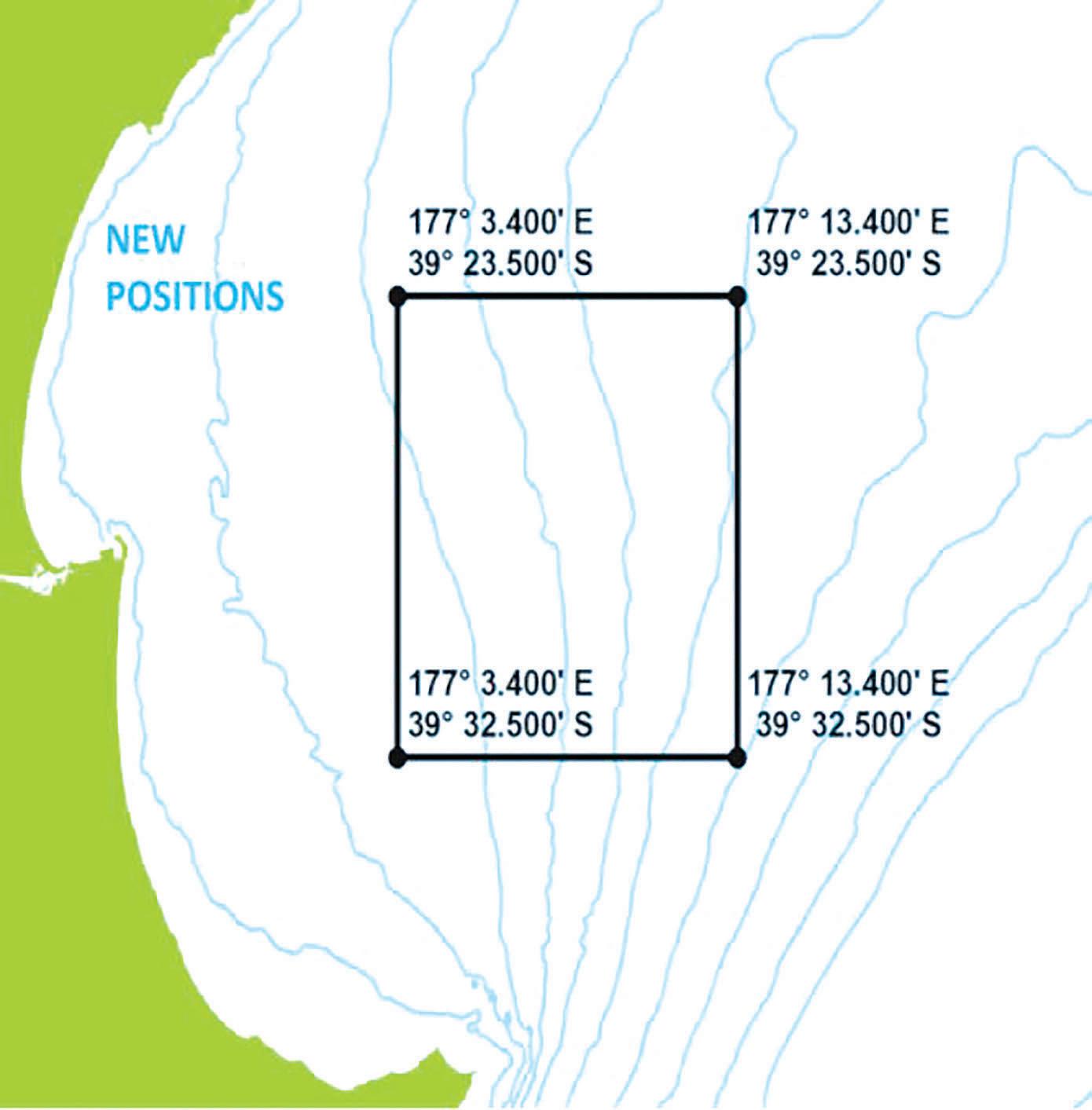
The meetings were attended by LegaSea Hawke’s Bay (a subbranch of LegaSea and outreach arm of the New Zealand Sports Fishing Council), 15 fishers, Seafood New Zealand Inshore Council (formerly Fisheries Inshore New Zealand), Te Ohu Kaimoana, as well as several local seafood companies.
“There were around 22 people all up,” said Rick Burch.
“At the start, it was a bit fiery. It took about six months for things to settle".
“From there, we started working on picking the low hanging fruit".
“Things we agreed
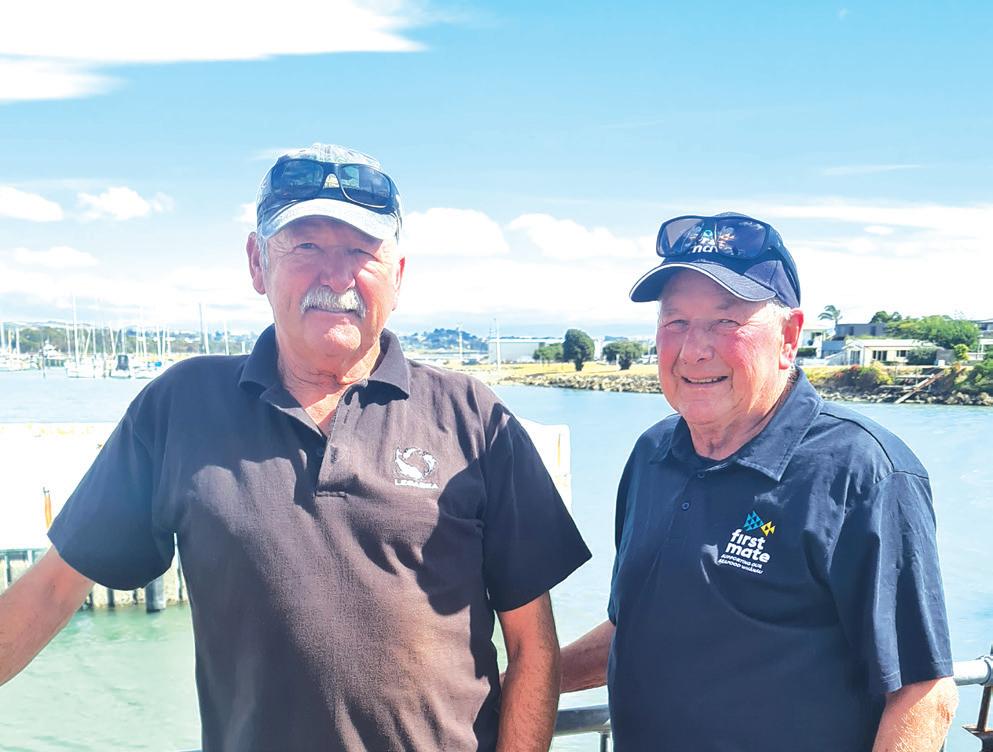
on.”
One of the things both sides agreed upon, was the evidence they had seen with their own eyes, snapper and gurnard spawn out in the Springs Box area in December and January.
“That’s when we agreed we needed to do something to protect that area while it’s spawning,” said Wayne Bicknell.
“So, we started to get this voluntary arrangement going, drawing up the box area together.”
Burch says the map took a bit of finessing as commercial fishers soon realised it was a little too close to Cape Kidnappers, which was a safety concern.
The hard work to get it right paid off, as the Springs Box has remained largely unchanged ever since, and this voluntary arrangement has become so widely accepted by all parties, little negotiation is needed when the agreement is revisited each year.
From the recreational side, while the Springs Box is closed to commercial fishers, the Hawke’s Bay Sports Fishing Club keeps a close eye on what

comes out of the area via their Colin Murray Ramp survey.
“Every fishing contest the club has, we ask all the fishers to fill the survey form out and pass it to us as they come up the boat ramp,” said Wayne Bicknell.
“There is a box they need to tick to say if their catch has come out of the Springs Box area.”
While from different fishing worlds, Wayne and Rick are long-time friends, having met when Rick emigrated to New Zealand from the United Kingdom in the 1980’s. They share a passion for the sea – whether it’s surfing, fishing or looking at ways to preserve it.
“We have had many a heated discussion around the dinner table, which p…es everyone off,” says Wayne.
“But our friendship has helped to make this voluntary agreement a success – because Rick is the go-to for commercial fishers, and I’m one of the go-tos here for recreational fishers.”
“We both stand up for our organisations, but we’ve found ways to work around things,” said Rick.
Rick also says, one of
the positive outcomes of this agreement is there is more respect for commercial fishers.
“The agreement has really helped improve the relationship we have with not just LegaSea Hawke’s Bay, but with the wider public,” he said.
Seafood New Zealand Chief Executive Jeremy Helson who, in his former role as Chief Executive of Fisheries Inshore New Zealand, was part of the early discussions around this agreement, says he is pleased to see the arrangement has continued.
“Hawke’s Bay really has something special here,” Helson said.
“This local initiative is an excellent and too-rare example of the compromise and collaboration possible between competing sectors.
“It would be great to see this happening in other parts of Aotearoa.”
While arguments can happen from time to time, both Rick and Wayne agree the Bay has got to be looked after, and it makes the best sense to be doing it together. They hope the agreement will continue for many years to come.

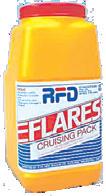




4 THE FISHING PAPER & HUNTING NEWS - MAY 2024 FIND US AT THEFISHINGPAPER.CO.NZ AND FOLLOW ON FACEBOOK
transforms tense relationship between commercial and recreational
Springs Box
WESTLAND ENGINEERING SUPPLIES 10 Boundary St, Greymouth Ph (03) 768 5720 Fax: (03) 768 0907 plus • RFD J ackets • Flares • Predator Electric Kontiki • Surf rod & reel sets • Fishing tackle • Caltex marine & motor oils CALL IN AND SEE US FOR ALL YOUR MARINE AND ENGINEERING SUPPLIES New Expo expected to attract ten’s of thousands of visitors 14th & 15th September There’s a lot of buzz and enthusiasm for what’s shaping up to be the major event in the South Island for outdoor lovers. From boat builders like Image,4 x 4 outfitters,semi offroad caravans and gutsy capable 4WD vehicles like JEEP,fishing,hunting and camping gear and everything in between it will all be on show at the outdoor Expo. Early bird pricing for exhibitors and ticket sales close end of May for the September event in Christchurch. www.outdoorexpo. co.nz
Wayne Bicknell and Rick Burch
Boat Ramp Shenanigans
Sunday was promising to be a mint day out on the water, or at least that’s what Dan kept telling me.
He’d been watching the forecast intently over the school holidays to see if we could get out as a family on the boat, which doesn’t happen very often with school and work.
A horrible wind Saturday wouldn’t let up, so we made the decision to go out Sunday for a few hours in the bay. This meant we could take our dog out on the boat with us for a trial run.
Our daughter, Brianna, is not a fan of an early wake up, especially when it’s the last chance for a sleep in, but once up and about we were both feeling good. Me with food and coffee in hand and her with a pillow, we met Dan down at the boat ramp.
As we were walking around the Waka ama parked by the ramp we heard someone yelling out.
“Hey that’s Dad,” Brianna said.
As we came up next to him, he told us what had happened. Our boat was tied up at the very back corner of the floating jetty. Dan was watching the boats launching and was paying particular attention to one he had seen hit another boat once before.
The five guys on board were half-way down the jetty, when they tried to push off the wharf, then one of them got the plastic paddles out and tried to paddle backwards off the wharf.
After multiple attempts they finally got the motor started, put it into reverse to try to get off the jetty, when the motor cut out again. The engine was re-started, and then the driver shoved it into gear and took off heading straight towards our boat. They all started yelling at each other, pointing at
our boat.
Dan yelled out at them, and they ended up pushing off our bow rail to avoid a collision, before heading out seemingly unphased at how close they had come to ruining a perfect Sunday.
So, with near-miss number one averted, we set off. There was a little bit of slop initially, which just eased out until the sea was glassy calm. Our dog was initially very interested in each fish that came on board then decided she didn’t like the splash in the face so settled for lying in her bed in the sun.
It was on our return to the boat ramp nearmiss number two occurred. There were a few people retrieving their boats seamlessly, and there were several smaller vessels returning.
I backed the trailer down the outside of the boat ramp to enable the smaller vessels to tie up to the jettyparticularly favoured
Nelson Marine Centre - OPEN NOW
Nelson Marine Centre Ltd, Nelson Tasman’s newest YAMAHA Dealer and your one-stop shop for boating needs, with the flagship Retail and workshop space in Richmond, is now open to customers. The new venture
 Angela Govier
Angela Govier
by those who are operating solo or need to tow the boat onto the trailer with a rope.
Fortunately, when it was my turn to back the trailer down, the left-hand side of the ramp was free, so I managed to get down there easily enough.
There were a couple of boats tied up to the jetty and one ‘preparing’ to launch on the jetty side. At least I thought he was. As I was checking the boat catch was set for retrieval, I saw the boat being launched out of the corner of my eye.
The boat pushed off the trailer and then drifted off in front of everybody else, the skipper was fluffing about on board without the motor even going!

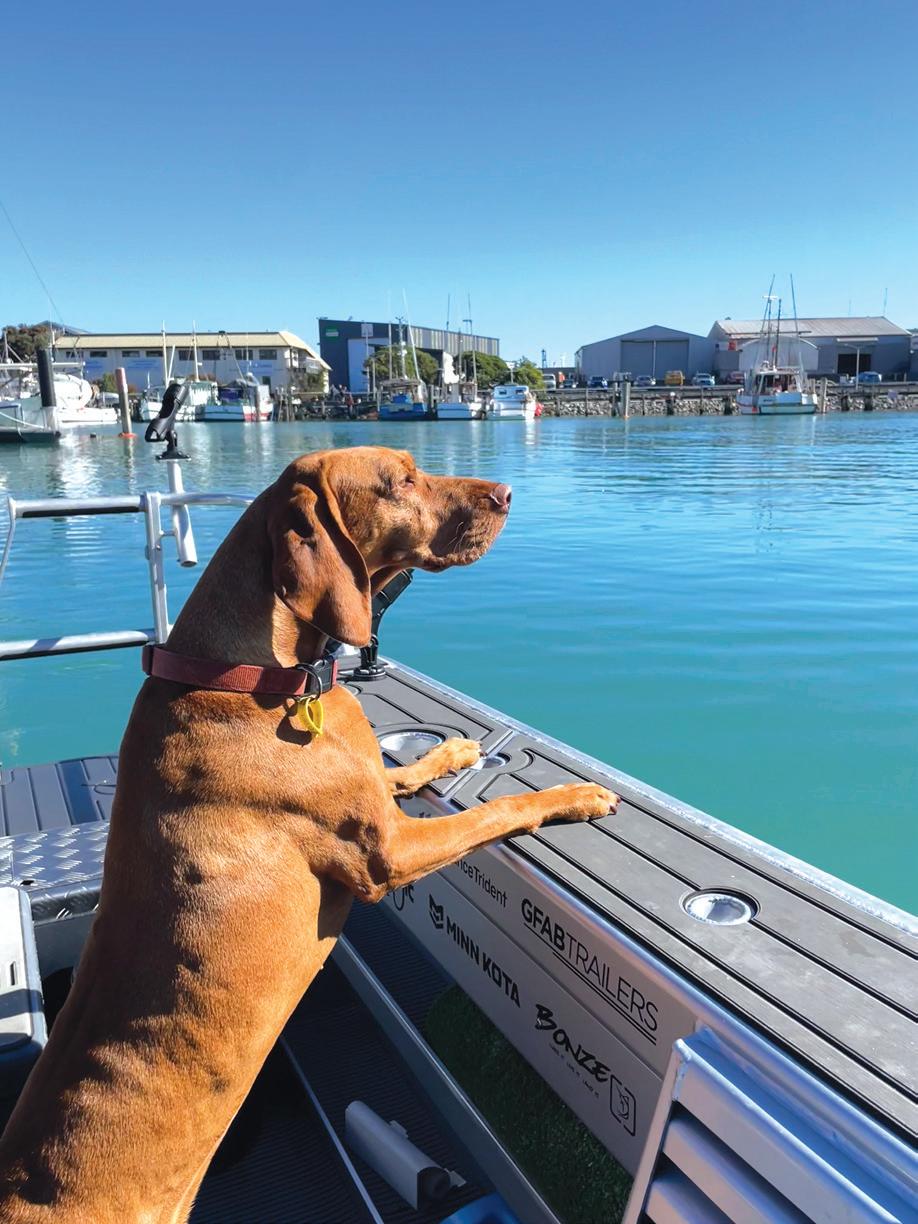
Thankfully, Dan was sitting further away ready to manoeuvre onto the trailer so was able to reverse out of the way of the drifting boat. Lucky that the boat did not drift towards those tied up to the jetty.
Eventually he
results from months of hard work by managing director Pete Walters and operations manager Mark Wiblin, who have worked together for years. Having made the jump from Marlborough, they are now firmly settled in
Nelson, bringing their combined decades of financial and technical experience and reputation for stellar customer service with them.
Pete says he and the entire Nelson Marine team are looking forward to supporting

Arrow
Trevally
Tuna
locals and visitors to get out and enjoy the region’s stunning coasts and bays.
“Whether you’re a seasoned rider craving high-speed adventures or a newcomer eager to explore the open waters, Nelson Marine is dedicated to providing unforgettable moments on the water.”
“One of the best parts of my job is getting to be a part of everyone’s adventures –whether you’re out on a fishing trip with family or spending a summer holiday together. Mark and I get a lot of joy out of doing that year after year.”
Nelson Marine Centre will offer
an extensive selection of topof-the-line Yamaha outboards, Waverunner Jet Skis, safety equipment, and marine accessories to suit every preference and skill level. For each Hutchwilco life jacket sold in May, Nelson Marine Centre will donate $10 to the Nelson Tasman Hospice’s fundraising appeal.
In addition to sales, the dealership will offer maintenance and repair services, ensuring customers receive ongoing support and assistance to keep their Yamaha marine products in top condition. Nelson Marine Centre also
dropped the motor, started the engine and was able to steer the boat as opposed to drifting aimlessly. Near miss number two averted, we headed home to clean up and put our feet up for the last few hours of the holidays.
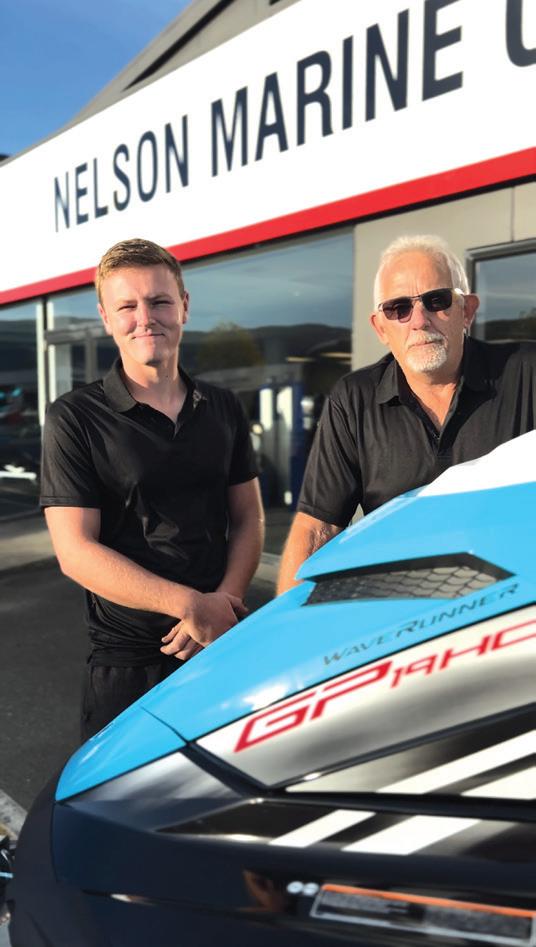
offers a range of financing options to make purchases more accessible.
Address: 23 McGlashen Avenue, Richmond, 7020
Opening hours: Mon – Fri: 8am to 5pm, Sat: 9am – 1pm
Website: www. nelsonmarine.co.nz
Issue 224 FIND US AT THEFISHINGPAPER.CO.NZ AND FOLLOW ON FACEBOOK 5
Pr"'e,�m Raif VUI" h- :J61Al--:'JmDEL1vERm OVERNIGHT DIRECT TO YOUR DOOR VIA NZ POST �) Solander orders: call 0800 555 548 email: seafood@�olande r.com (t, ,) www.gourmetseafood.eo.nz/prem1um-ba1t � OCEAN TO PLATE Bait options available
asman Bay 8kg Bait Box
Tuna (Baby Bonito)
Sides approx 2kg
Squid Premium Grade 100-200g
T
Bullet
Barracouta
Arrow
Squid Bait Ungraded
on
Skin
Fillets
Burley Bombs approx 2kg
& Squid

PULSAR MERGER LRF
MERGING CLASSIC DESIGN WITH ADVANCED TECHNOLOGY
The Pulsar Merger LRF thermal binocular delivers a comfortable, immersive viewing experience with enhanced detail rendition. Viewing with both eyes also reduces eye fatigue during prolonged observation periods.
Pulsar Merger LRF common features
• 1000m laser rangefinder
• Lynred STD-810/833 TWS Qualified sensor
• Supplied with an APS3 battery and charger
• Quick-change battery with internal back-up battery adds significant operation time
• Tough waterproof magnesium alloy housing
• Overidable proximity sensor ¼” tripod mount
Three models available to suit various budgets and operational requirements.
Merger LRF XQ35
All the great features of its high-end siblings. Compact, great image quality, fog, rain and foliage penetration. Excellent value.
Merger LRF XP50
The most popular Merger combines fine image detail with deep fog, rain and foliage penetration. The best all-round Merger for Pros and hunters.
Merger LRF XL50
The ultimate thermal offers a very wide field-of-view, amazing image detail and high magnification zooming capability.


6 THE FISHING PAPER & HUNTING NEWS - MAY 2024 FIND US AT THEFISHINGPAPER.CO.NZ AND FOLLOW ON FACEBOOK Made in Europe Chosen by Professionals World’s Finest THERMAL IMAGING Model Price Sensor NETD Objective Lens Magnification Field of view (°)/m@100m Detection Range* Merger LRF XQ35 $6,499 384x288/17µm <25mK F35mm/f1.0 3 - 12 (x4 zoom) 10.7 / 18.7 1350m Merger LRF XP50 $8,999 640x480/17µm <25mK F50mm/f1.0 2.5 - 20 (x8 zoom) 12.4 / 21.8 1800m Merger LRF XL50 $11,999 1024x768/12µm <40mK 14 / 24.6 2300m
www.advancedoptics.nz Prices valid while stocks last. E&OE. Exclusive New Zealand distributor * Detection range based on object 1.7m x 0.5m
Keeping a thumb on the pulse – commercial pāua catch
sampling
Dr Tom McCowan , Paua Industry Council
Our pāua fisheries are managed at the highest level by setting catch allowances based on periodic stock assessments across the eight main pāua quota management areas (QMAs) (Fig. 1).
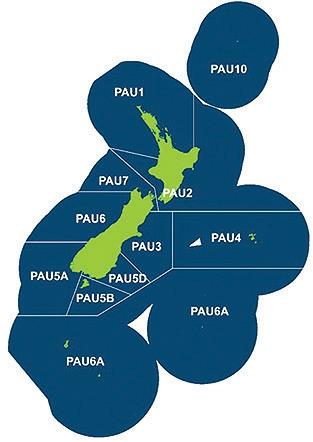
Stock assessment outputs help to determine whether current catch levels are sustainable. They rely on a range of data inputs, such as biological data (e.g., size at maturity and growth rates) and fisheries-dependent data (e.g., catch and effort data). One of the most important fisheries-dependent data sources is the size of pāua being commercially landed across the fishery.
Since 2006, the Pāua Industry Council has undertaken the Fisheries New Zealand contract to collect this data. Since the start of the project, the primary means of sampling commercial catch measurements has been through the “Red Sack” method. When
pāua are commercially harvested, divers fill hand nets of pāua, which are passed to the deckhand on the boat. The deckhand double-checks the measurements of pāua to ensure they are above the harvest size and sorts and stacks them into fish bins. Bins typically hold about 100 pāua and weigh about 25 kg. For each day’s diving, harvest crews are asked to randomly select one bin to be sampled, tagging it with details of the day’s catch (area dived and total catch). When this bin is processed at the factory, the shells from this tagged bin are kept aside and placed into a red sack with catch details attached. Shells that end up in red sacks are then measured periodically throughout the year by employed technicians (Fig. 2).
length of the shell, and a button is pressed to log the measurement. The ‘hump’ (the round bit of the shell at the back which protrudes past the underlying rim of the shell) can also be measured so that the ‘basal length’ (the length of the underlying shell rim) can be calculated by subtracting the hump from the overall length. This length is used to maintain consistency with NIWA’s data collected for stock assessment before this project, and data around hump size and frequency can also tell us about fishing patterns in some areas. Data from the measuring boards is then uploaded and processed to observe the length-frequency trends at the fishery level and is fed into stock assessment models.
In the last several years, there has been an uptick in the live export of pāua, meaning that catch length samples are no longer adequately
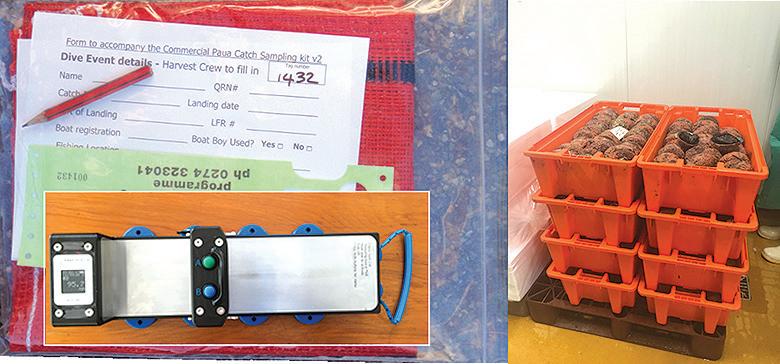
measure pāua live as they are landed on the vessel. The solution has been with modified measuring boards designed by Scielex that enable pāua to be easily automatically recorded as they are sorted into bins. The boards have a spring-tensioned book-end that pāua can be slid through, and measurements are automatically logged as the maximum gap. An alarm can also be set to indicate if pāua measured are below the harvest size as these are being checked. The machines also record the GPS location of the
the uptake of this new process, we are now collecting massive amounts of data that far exceed what was ever possible with the red sack method alone.
In the early days of this project, 30,000 pāua were measured a season. In contrast, during the last season, over 300,000 pāua were measured.
The primary use of this data is to feed into government stock assessment processes, which help determine the status of stocks across the QMAs and inform catch settings. Further to this, assessment of the catch length
the fishery is in a state of decline and that catch adjustments should be made. In most fisheries, the trend is towards increasing sizes of pāua, which is a positive sign. This has generally been driven by the move towards increasing minimum harvest size (MHS) to be more biologically appropriate than the minimum legal size of 125mm. For example, in PAU7 (Marlborough) 5 different MHS up to 145mm are implemented across the QMA commercially. Fig 4 shows how this data can be visualised and interpreted.
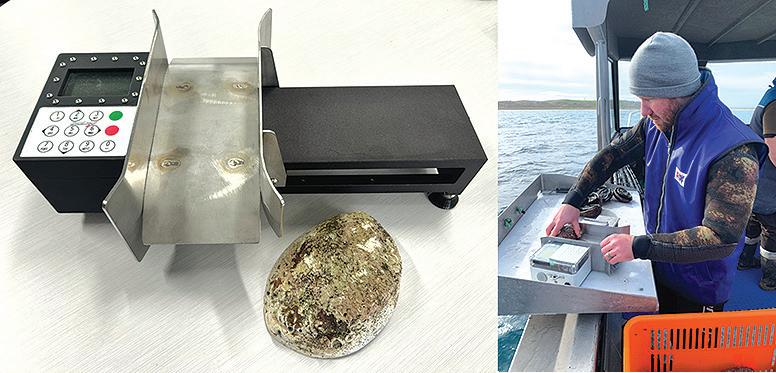

4: Examples of cumulative frequency plots help visualise the trends of pāua sizes across different seasons and across QMAs. The further to the right the line is, the larger the paua. The left hand plot shows that in PAU2 (Wairarapa) pāua have been getting incrementally larger over recent seasons, driven by increases to the minimum harvest size. The right hand plot compares the size of pāua across QMAs and shows the general pattern of larger pāua in more southern QMAs.
Shells are measured using this method with an electronic shell measuring boards designed by Zebratech Ltd. Shells are placed on the board, a sliding book-end is used to measure the overall
captured by the Red Sack process alone, as live pāua obviously do not end up being processed at the factory. This has required some recent innovation to develop a system to
samples measured, meaning data can be referenced back to the specific area of harvesting (Fig. 3).
Scieliex measuring boards are used by the primary harvest crews across each QMA. With
data can also provide interesting insights into the performance of the fisheries around the regions. For example, suppose shell sizes are decreasing over successive seasons. In that case, it suggests
Overall, this project is a great example of Industry being actively involved in innovative means of data collection to ensure the overall sustainability of fisheries for all users.
Issue 224 FIND US AT THEFISHINGPAPER.CO.NZ AND FOLLOW ON FACEBOOK 7
Fig 1. Map showing the pāua quota management areas (QMAs). The primary areas are PAU2, 3, 4, 5A, 5B, 5D and 7).
Fig. 2: The “red sack” process – random bins of pāua are tagged by harvesters, and shells are measured after processing.
Fig. 3: Onboard measuring of live paua.
Fig.
Hunt Africa 2025 with fellow Kiwis
Now is the chance to make your dream a reality! Don’t procrastinate any longer.
I have put together a group hunting safari to the East Cape Karoo for 2025 and there are still spaces available, so grab your chance now. Why?
A hunting safari is best shared; sitting around the campfire at night; reliving the challenges and excitement of the day’s hunt with fellow hunters is what it’s all about. Imagine the crackle and flicker of the lead wood fire as you enjoy a ‘sundowner’ while swapping tales—the darkness punctuated by the banter of jackals and the eerie cry of the fiery-necked nightjar as it wails, “Good Lord Deliver Us Deliver Us!”
There are other advantages to joining
our safari: all the organising is done for you, from itinerary, camp bookings, flights, accomodation, permits, taxidermy, shipping and custom clearance—all you have to worry about is enjoying your hunt. And there are cost savings. With group shipping consignments, I am able to spread the many fixed fees over the whole hunting party, which makes the safari more affordable for you.
Our hunting properties are large and home to established populations of quality wild animals, so you get to experience an authentic fair chase walk up African safari. We do not entertain the ‘put and take’ operations that recycle game bred animals, which are becoming common. And we do not shoot from
Daryl Crimp
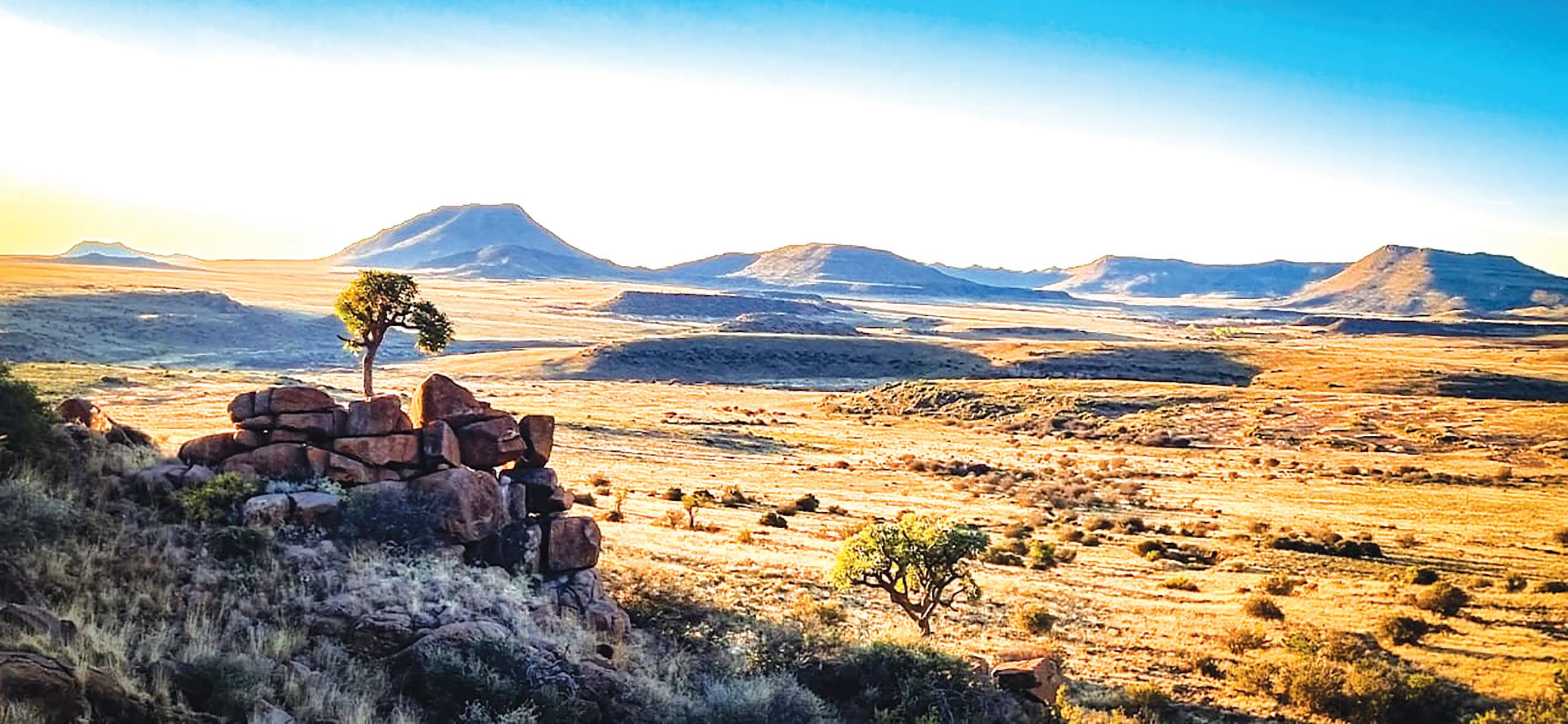
vehicles. We do it the real way—the Kiwi way.
The camp atmosphere is amazing. We use authentic safari tent camps or small bespoke lodges that appeal to Kiwi hunters. Our operators are professionals who have been in the safari business for generations; their whole lives revolve around hunting, so they are passionate about

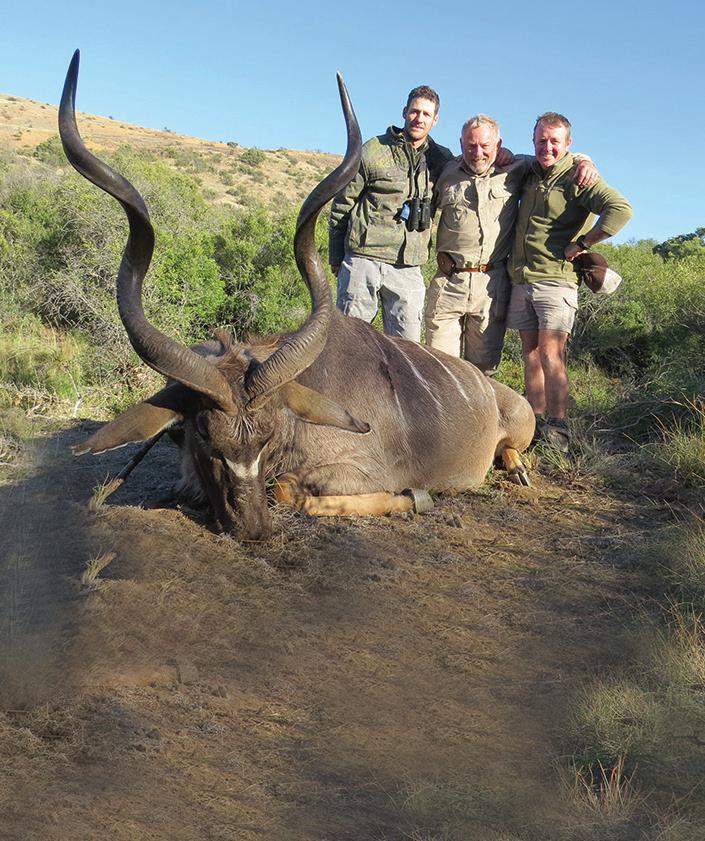

giving you the best hunting experience possible. And the native staff are simply wonderful. Warm, friendly and generous. Most importantly, the
hunting is sublime. East Cape is currently the ideal destination for Kiwis, as it is much more affordable than northern parts, with plentiful plains game
and amazing vistas.
I have hunted Africa regularly over the past decade and introduced a lot of Kiwi hunters to the Dark Continent. Many have returned several times. Call me now to book your space on this amazing safari—there’s no better time!
Crimpy 021 472 517
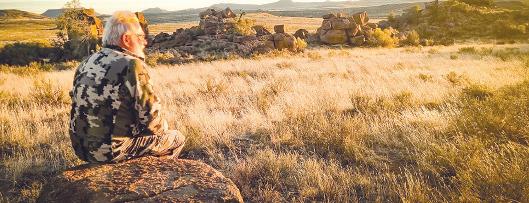

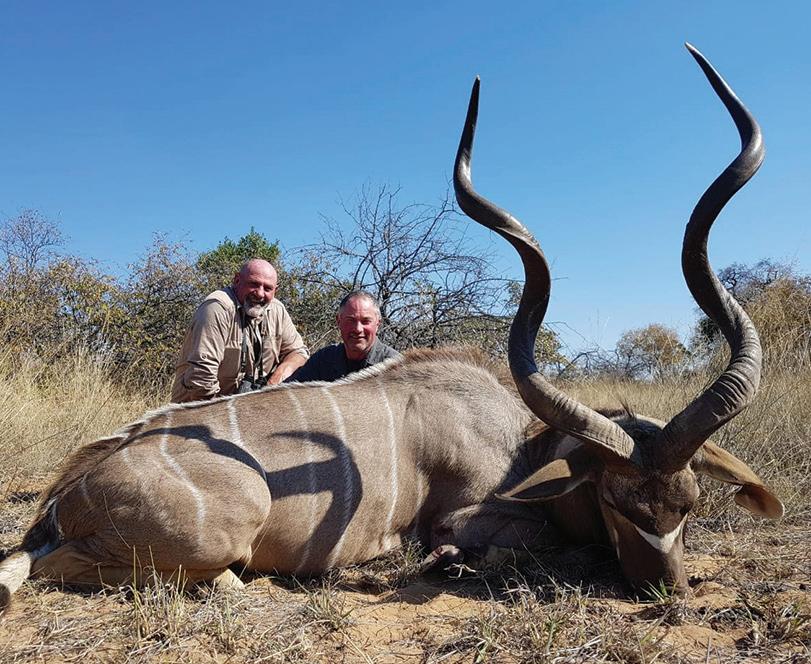


8 THE FISHING PAPER & HUNTING NEWS - MAY 2024
EastCapeKarooGroupSafari2025 EnquireNOW!
Land Search and Rescue Celebrates 91 Years of Heroic Service with "Searchlight" Campaign
Land Search and Rescue, a national volunteer organisation dedicated to saving lives and providing critical support to the lost, missing and injured, is excited to announce its upcoming May campaign, "Searchlight."
This special initiative is designed to commemorate the organisation's remarkable 91-year journey, showcasing the selfless dedication of volunteers, the countless hours invested in community safety, and the numerous lives saved through their tireless efforts.
National Reach and Specialised Disciplines:
Land Search and Rescue is a national volunteer organisation with over 3,300 trained search and rescue volunteers who are members of 64 local groups covering the length and breadth of New Zealand. Volunteers operate in suburban, urban, wilderness, and rural areas, including regional and forest parks, mountains, shorelines, canyons and caves.
Unpaid professionals offer their specialist search and rescue skills free to the public 24 hours a day, 7 days a week via the New Zealand
Police and the Rescue Coordination Centre. Specialist disciplines such as Land Search and Rescue Dogs,
CaveSAR, CanyonSAR, Alpine Cliff Rescue (ACR), and RiverSAR operate on a local level where there is a
Volunteer Impact:
requirement for these specialist skills.


Drone Fish Update - Autumn arrives
As winter draws closer with each weather cycle, most have slowed down fishing around the coast but there’s still good days to be had.
We recently stumbled on a gurnard spot a 15-minute drive from home and have had regular catches, most days getting at least a few over an hour period.
Rig and elephant fish are in the local rivers, more rigs being caught on rods but locals with nets have had great catches in their nets.
We were out a couple of weeks ago and sent out two rods with the new Aeroo Pro drone, which we are

currently doing test flights for , before their commercial release at the end of April.
We set one line out 300 metres and the other around 400 metres, Andy was down with his Shark X drone just up from us.
The lines had been out about an hour with no nods. We were chatting with Andy next to his rod and he had had no bites. I looked up and saw my rod buckled over and could hear the reel peeling line off from 100 metres away.
From July 2022 to June 2023, our volunteers donated over 102,627 hours to Search and Rescue activities. In the official stats for the year 2022/23, Land Search and Rescue engaged the dedicated efforts of 3,667 volunteers during these search and rescue operations (SAROP), totaling an impressive 18,090 volunteer operational hours. The organisation conducted 456 operations, assisting 161 persons, and successfully rescuing 160 persons. This remarkable feat underscores the dedication and effectiveness of Land Search and Rescue in fulfilling its mission to save lives and provide crucial support to the lost , missing and injured.
Volunteer Hours:
Land Search and Rescue owes its success to the extraordinary volunteers who tirelessly contribute their time and expertise. The Searchlight campaign will shine a spotlight on the countless hours these dedicated individuals have invested in training, preparedness, and actual search and rescue operations. Their commitment has been instrumental in the organisation's ability to make a positive impact and save lives.
Wayne Gillard
I picked up the rod and it buckled over as I put some tension on it. I had to take a few steps forward as the rod bit into my hip. I got it back into the holder and reset the tension.
As I got to my rod it went slack. I wound in about 100 metres of line and had weed on it from the shallows. I laid the rod across the beach spike and as I finished taking the weed off my line it started peeling line off again.
The fight started with the fish moving across the beach then back again. We gained some line then lost some more. After 10 minutes I looked out across the flat seas and saw two fins breaking the water. A sevengill shark I thought, another 10 minutes later it was in the shallows.
As Tash walked out knee deep, “blue shark,” she said. Great, our biggest one yet.
We got it into a foot of water, and it was really a solid fit fish, hooked in the corner of the mouth. We managed to get the hook out with our fingers and not hurt the fish. A few quick photos and we wrangled it back to deeper waters to live for another day.
To be honest I was knackered. We got back to the other rod, and it was nodding, not to the same extent, but we were rewarded with two fat gurnards, our karma for releasing the blue shark. Andy got two gurnards also so a successful morning all round.
Issue 224 FIND US AT THEFISHINGPAPER.CO.NZ AND FOLLOW ON FACEBOOK 9
Are you ready for the duck hunting season ?
Being prepared is an important step to having a successful duck shooting season. What preparation work should you do in the lead-up to the opening weekend? A few steps now can help make your season the best.
Guns
Starting with your gun, make sure it is clean, this is especially true for gas-operated semi-automatics to make sure the piston and port holes are clean and clear. One year I didn’t do this, and it was a frantic effort to try and clear them with some manuka sticks to get it functioning correctly.
If you’ve picked up a new firearm or new ammunition, check the gun is fitting you correctly, so it is shooting in the direction you are looking.
There are a couple of ways to go about this. The first way is to have a friend available, make sure the firearm is unloaded, and do a couple of test mounts pointing at something on a wall about head height. Once you are comfortable mounting the gun in the same place hold your head and position. Your friend can then look down the rib and check the bead is flat to your pupil. Most firearms come with shims that allow the stock to be moved to fit if the gun isn’t right for you.
Another way is to get a piece of paper and draw a small circle on it, stand about five metres back, aim at the circle and look at the impact relative to the circle, you can adjust the gun to fit.
Almost as important as your gun fit is to test your chosen ammunition at your shooting distances and check the pattern is tight enough. Here we
are getting a 2D view of the 3D shot string, while not perfect it does give a good indication. There are plenty of guides online searching for ‘shotgun patterning.’ I like to have a tight pattern to limit the chances of injuring a bird. I may miss more but I feel it’s a reasonable tradeoff. Try the different chokes that come with your gun, but note modified, ½ Choke, 3 notches, is the tightest recommended choke with steel.
Getting your eye in
Once you have your gun sorted, heading out to one of the sponsored ‘duck shooter’ shoots near you offers a great chance to get your eye in. These are often sponsored by your local firearms store and offer you the chance to try some of their firearms if you want to upgrade. If you are having trouble with certain types of targets don’t be afraid to ask some of the experienced hand shooters around for any help or tips. Squad mates standing behind can often see where you are going wrong.
Another great way to improve your shooting is to chase nongamebirds like pigeons and geese. Pigeons are an excellent bird to hunt, they decoy. Not much extra equipment is needed, homemade silhouettes and your mallard spinning wing decoy are often enough to get them to decoy if you have found where they are feeding. Pigeons also decoy into their dead so any birds lying on the ground, make sure to bring them into your spread. With these birds, the first shot is reasonably easy, but any others can be a real handful.
Decoys
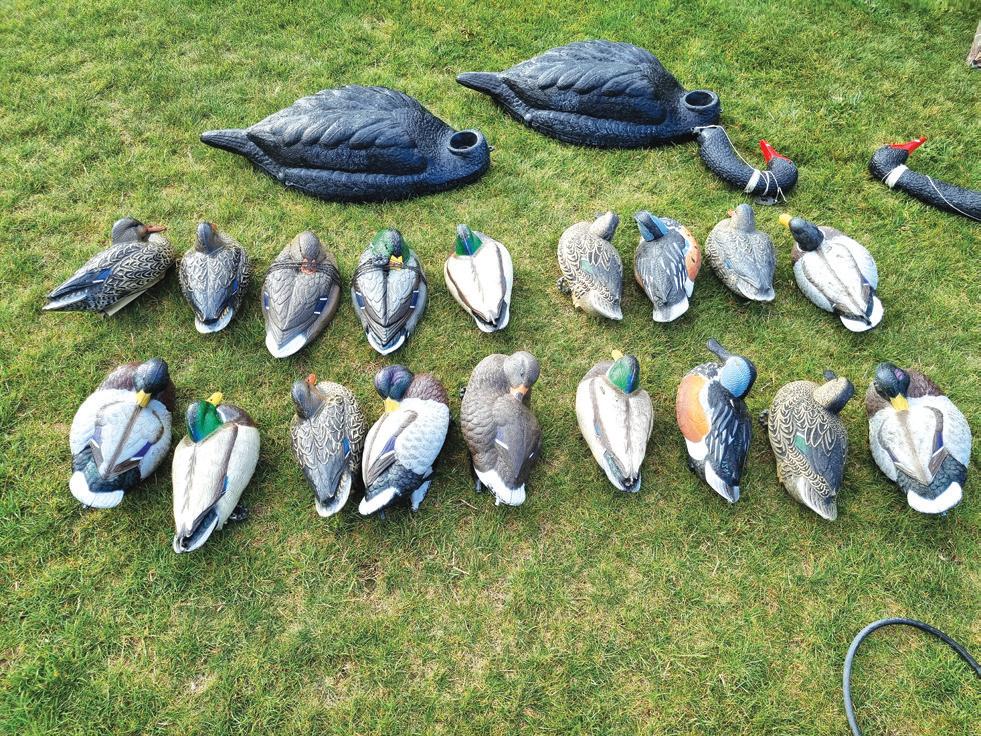
Decoy maintenance in pre-season is important, have you ever got out to your spot and found all the cords in a tangle, and you had to spend a crazy amount of time trying to get them sorted in the dark with a headlamp? A bit of time before getting them tidied away can save a stressful morning. Slotted decoy bags work well to keep your decoys organised over mesh bags. Bike tyre tubes cut into rings and tied onto the sinker make easy rubber bands to keep the cords tidy. Clean decoys work better in the field. Using two pieces of wood with some bungee cord holding them together clamps onto the keel well, which is easier to hold with your foot. Then run a water blaster over the decoy removing any dirt. If any of your decoys rattle, find the holes and plug them up with some silicone if possible. A half-sunken decoy can make even the keenest duck flare from your spread. For any motorised decoys you have, make sure to have fresh batteries and that rechargeable batteries are charged. Check the decoys are working, last season I found with my spinning wing decoy the on/off switch had failed and would not turn on. Because I checked it early , I found a replacement and fixed it.
this pond, we topped the feeders up twice a week from 3-4.00pm. Doing it late afternoon meant ducks would be sitting on the pond all day and when chased off go out for a night feed and come back in the morning. If it is a night-shooting pond, feeding in the morning would also work. A popular method is using auto feeders you can set the time and how long they run for. We have tried these
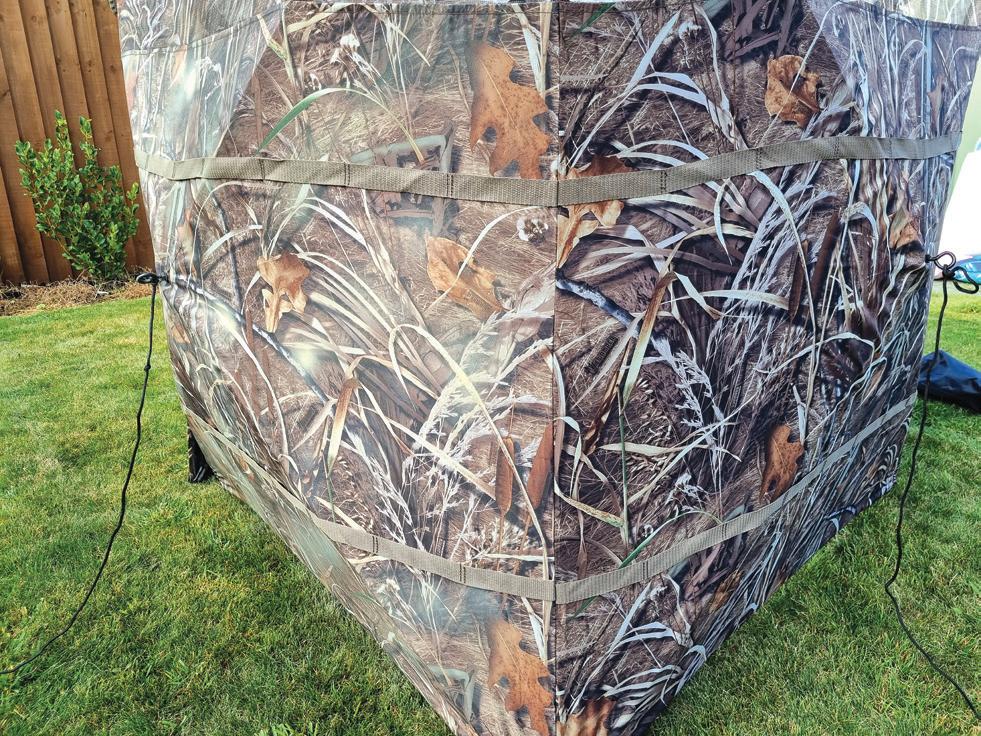
Getting into your pond and maimai at least a month before opening weekend to get this done is best as it gives a chance for the ducks to get used to any changes. For your maimai does the vegetation need to be replaced or can the new cover be added to the existing? Check there are no holes in the floor, and nothing is rotting. You don’t want to be out there opening morning and fall through the floor. Feeding a pond can be a good way to increase birds on your pond. Depending on what fish and game region you are in this may not be possible, but for those that can there are a few different ways and feed to give ducks. In the past, we have had success with using maize out of a 40-gallon drum with a spring on-demand feeder. These feeders were set up in shallow water to stop rodents from being able to access the feed. On
to deal with that for the rest of the day. Is your waterproof gear still waterproof or do you need that repaired or replaced? Being dry and warm could be the difference between staying out and shooting some ducks or being forced to head home.
Blind Bag
What do you have in your blind bag that may need looking at? Duck callers do need some pre-season love. Are the reeds okay without any splitting and does the caller sound okay? There isn’t anything stuck in there? One year I had left mine hanging in the corner of the garage and when I came to use them, I found a spider had made a nest in them. It may have only taken 10 minutes to pull and clean them but
and monitored them with game cameras. We found that when they ran the ducks flared from the noise they made and left the pond. Other people have had success with them so a bit of trial and error may be needed. The other way to feed a pond is to hand feed by tipping bags of grain or feed into the shallow water on the edge of your pond.
If hunting out of a laydown or pop-up blind, mudding them or spraying some matte paint over them can help reduce the glare and make them less likely to flare the ducks.
Clothing
An overlooked piece of equipment is clothing. Do your waders have any leaks that need to be repaired? It isn’t much fun having a cold, wet crotch, or socks at 6.00am and needing

that was time ducks were getting shot around me. Replace any batteries in your electronic callers if you use those. If you are not confident using duck callers, have them in your car and practice while stuck in traffic on your work commute. No one is around to complain about the noise.
Having a copy of the latest regulations booklet in your blind bag is helpful. This means you can doublecheck the regulations, with starting times and bag limits. Making sure
10 THE FISHING PAPER & HUNTING NEWS - MAY 2024 FIND US AT THEFISHINGPAPER.CO.NZ AND FOLLOW ON FACEBOOK
Maimai and Pond
Wild food recipes with Marcus
Crispy skinned duck breast with late summer berries and horopito on buttery silverbeet and scallop potatoes
Roll on autumn and what better way to celebrate than with a comforting seasonal nosh. I’ve chosen duck this time perfectly balanced with late berries and horopito, buttered silverbeet and crispy scallop potatoes, not too fancy but comforting and a perfect match for a nice red or pint of your favourite ale.




Opening weekendwhere memories are made
Rebecca Greaves
Duck - I have lightly seasoned the duck breast with ‘Smoke & Spice Co” seasoning and browned in a hot pan , add a cup of wild blackberries and some Horopito leaves into pan and place in hot oven for 12 minutes then cover and rest - don’t overcook.
Silver Beet - Place washed and torn leaves into pot with a touch of water, cook until wilted then drain, season and add a nob of butter.
Potatoes - roughly peel and slice potatoes into thin rounds, place in oven dish lightly covered in chicken stock and butter, season and oven bake for 20 minutes in a hot oven.
Layer potatoes on bottom of plate followed with silverbeet, sliced duck on top and finish with berries and pan juices - in the words of Tina …. “ Simply the best ! "
nothing has changed in your region from the previous season and staying within the law means when a Ranger comes to check , you know you are okay.
Your Best Hunting Partner
Last on my list but not least is your dog and making sure they are prepared for the coming season. I have found a few simple things can help in the performance of my dog. Give your dog the best possible chance by making sure they are fit and ready to do the hard mahi during the season. This can just be more regular walks and runs but what I find works well for my dog, Ace, is time at the river. Swimming and ploughing through the water works his muscles and stamina. You can also tie this into taking a simple bumper and getting him to do some retrieves and get into that routine.
With my bumper training, I have tried a few different things to

try and vary the work he is doing. Generally, I have duck wings taped to the bumper to give some scent and texture rather than a plain rubber bumper. A technique I like to use when on a walk in the park is to throw the bumper into a bunch of trees and continue our walk. On the way back past, stop and get him to hunt the area to find the bumper.
Hopefully, this gives you some ideas and you find something new here to improve your duck hunting season and make it a success.
Hot barrels and keep safe out there, keep the beers till
Opening duck shooting weekend means family and duck casserole. Ever since I can remember, my entire extended family has converged on our family farm in Hawke’s Bay on the Friday evening, a few yarns told and ports enjoyed beside the fire before retiring to bed, dreaming of ducks raining down from the sky when Saturday morning dawns.
In reality, we don’t seem to do too well on the duck count (well, not in recent years) but it’s the coming together, sitting in the maimai on a freezing morning, someone attempting to call them in. Always hoping for low cloud cover to encourage our feathered foe to fly lower.

excellent Jack Russells fetching the birds.
after the guns are away.
Gareth Faulkner , You can catch me online at parriehunter. co.nz or on Facebook and Instagram under Parriehunter.
Over winter I will be on a river bank, in a swamp or sitting on a pond with a gun and my dog beside me.
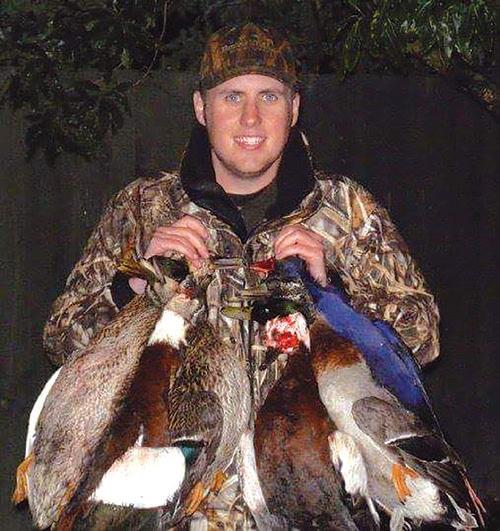
We don’t sit on one dam all day. After the morning shoot, we all troop home to compare numbers and inhale a cooked breakfast. Then we all do what is known as ‘the long walk’. This involves stalking the creek and majority of dams on the farm and, as the name would indicate, a fair bit of walking.
I much prefer the stalk to sitting on a dam all day. I’m not the most patient person and I enjoy the element of surprise – will there be ducks when someone gives the nod and we climb over the dam wall?
Dogs have always been a big part of opening morning, a succession of
On the odd occasion we’ve been without a dog my brother, aka the golden labrador, has been known to strip off, with the cry, ‘no duck left behind’. In desperate times we have also employed the services of the wooden ‘dog’ - a piece of wood tied to a rope and thrown out to pull the unlucky birds in.
20 gauge shotgun. I don’t shoot a lot, and I’m unsure how many ducks I could seriously claim, but opening weekend is one I usually don’t miss. I also have a fairly handy labrador, Greta, who is very enthusiastic about duck retrieval.
To top it all off, my aunties and any nonshooting cousins come out at lunch time. Mum always keeps ducks from the previous

When I got sick of being the dog handler and watching everyone else have all the fun, I decided to get my gun license and my father kindly purchased me a lovely
year in the freezer for opening, as it’s tradition to have duck casserole (grandma’s recipe) for lunch. You generally couldn’t pay me to eat casserole, but this is the best.
The day finishes with a bit more stalking, a lot more banter, and a night shoot in the maimais.
Issue 224 FIND US AT THEFISHINGPAPER.CO.NZ AND FOLLOW ON FACEBOOK 11
presents the Finest Culinary
in the World Pure New Zealand Sea Salt is hand smoked over Manuka wood fires, then tumble roasted with pure New Zealand Garlic, Shallots, Coriander, Mustard Seed and the mighty Chilli. The result is outstanding a seasoning with complexity and depth of flavour considered by Chef’s and culinaires the world over to be the finest seasoning ever produced. The finest mineral based sea salt, harvested from the pristine waters of New Zealand, is used. From seafood to red meats, BBQ to vegetarian, this all-purpose culinary seasoning has a unique plateau of flavours that compliment all savoury foods. THE ORIGINAL SMOKE & SPICE COMPANY CHRISTCHURCH, NEW ZEALAND www.smokeandspice.co.nz
Seasoning
Vehicle Fitouts - Fit for Purpose
Our fit-outs are crafted from premium aluminium, the ideal material for utes. We utilise heavygauge aluminium to withstand the toughest challenges and work life. Lightweight yet incredibly robust, our fit-outs are built to last and engineered for their intended purpose. Moreover, aluminium is corrosion-resistant, ensuring that your fit-out remains impervious to various loads.
Whether you're a skilled tradesperson, a DIY enthusiast, or just a fan of utes, our custom fit-outs are tailor-made to elevate your road transport
experience. Our fitouts not only meet but often exceed expectations in terms of quality and aesthetics. We take pride in collaborating with you to design the perfect deck or canopy, whether it's transforming your hand-drawn vision into reality or utilising our cutting-edge SolidWorks design system to bring your ideas to life.
Our fit-out solutions include toolboxes, folddown sides, hydraulic lifts, H-frames, slide out drawers and more to make the most of the space in your vehicle. We're your one-stop solution for all your transportation needs.
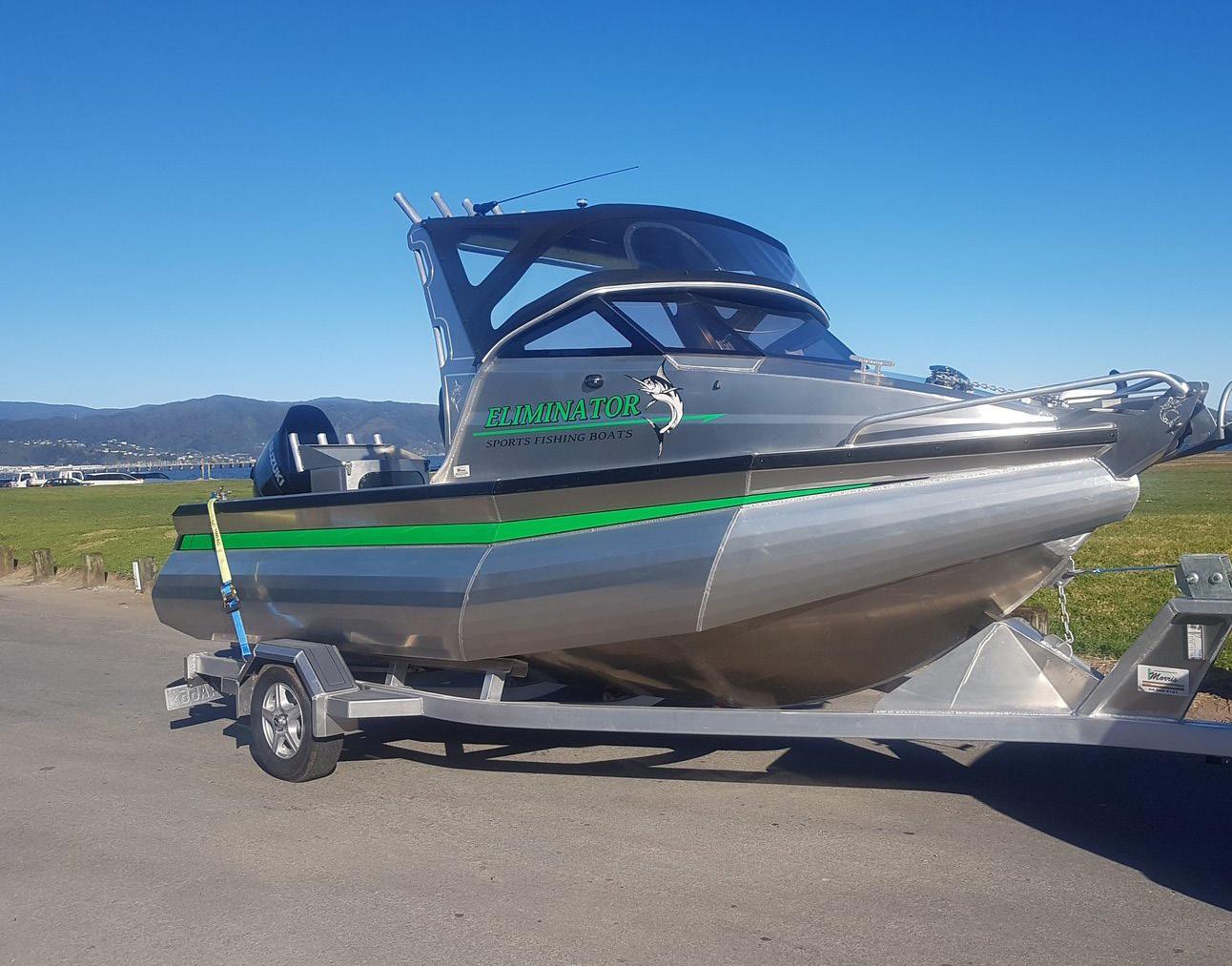
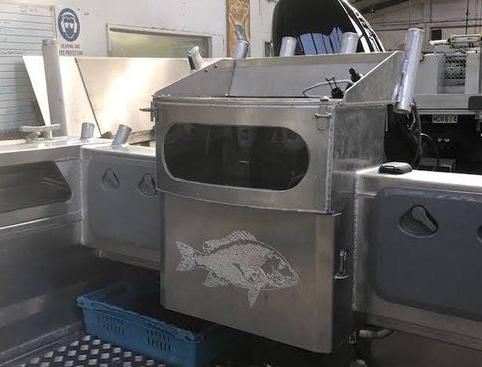
If a custom high quality sliding drawer for your wagon is what you’re after, we can do this for a side or back opening door. We use sturdy, customised parts so your drawer glides with ease, to make the most of hard to reach places. An example we’re very proud of is the drawers in a fleet of ambulance First-
Responder utes to make access to key materials easier for paramedics. Choose our fitouts to enhance the functionality and durability of your ute. Contact us today to discuss your specific requirements and take your road transport to the next level.

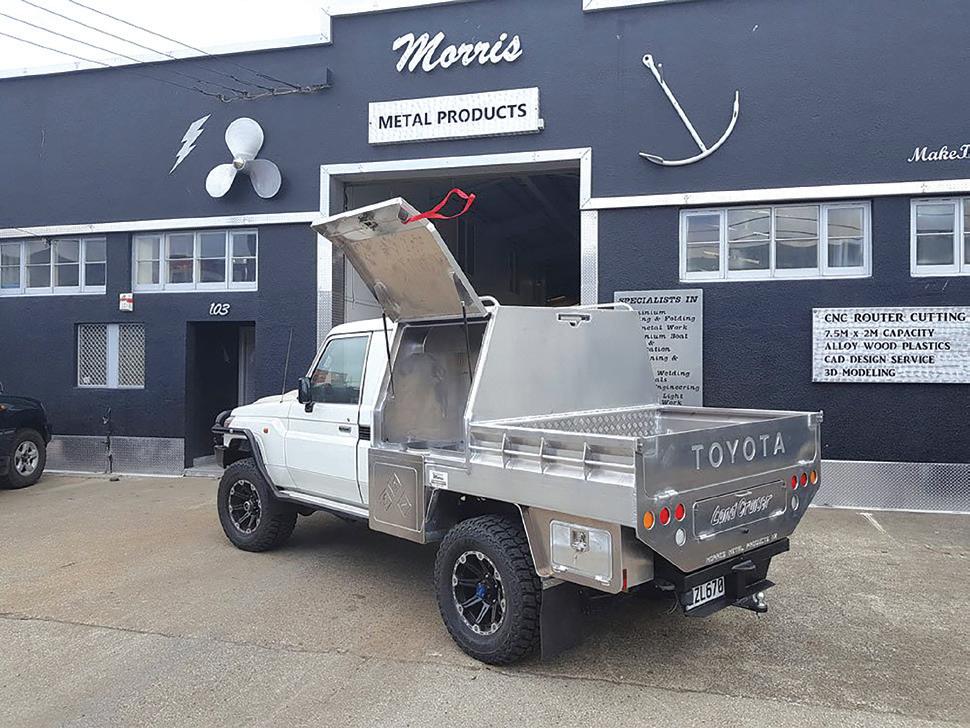






• New boat
• Custom designs • Repairs • Modifications
• Trailers
• Marine projects Our reputation speaks for itself, and our work consistently exceeds our customers’ expectations. Visit our website to see more. morrismetals.co.nz
12 THE FISHING PAPER & HUNTING NEWS - MAY 2024 FIND US AT THEFISHINGPAPER.CO.NZ AND FOLLOW ON FACEBOOK 103 Nelson Street, Petone, Lower Hutt 5012 P 04 5689181 - enquiries@morrismetals.co.nz Morris Metals is your trusted aluminium fabrication and repair experts When you choose us, you’re choosing the best in the business Get in touch with us today
all types
metals,
in aluminium. What we do
Over 30 years experience working with
of
specialising
builds

DRONEFISH.CO.NZ

•
•
•
•
•
•
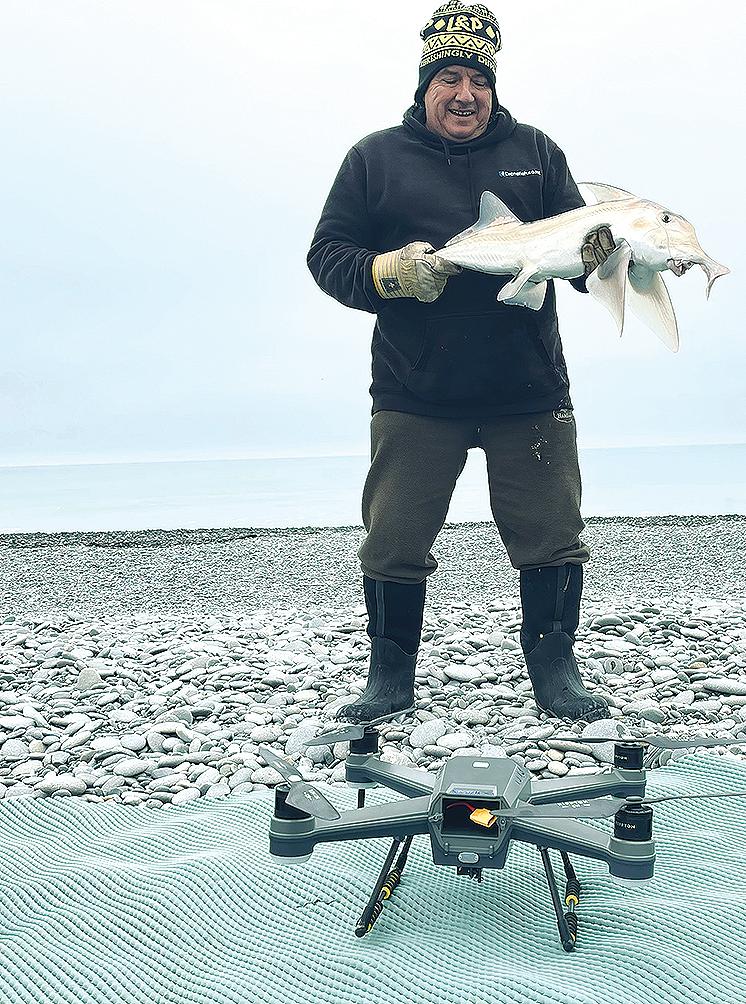
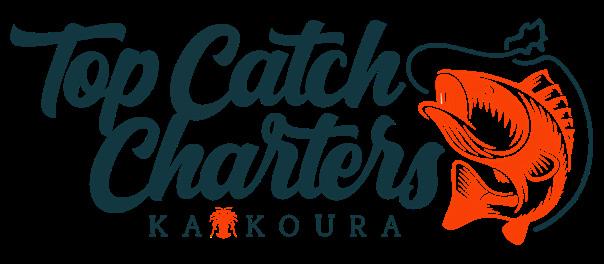
WE SPECIALISE IN HOSTING FISHING TOURS FOR GROUPS OF TWO TO SIX PEOPLE ALONG THE
RUGGED COASTLINE OF KAIKOURA, NEW ZEALAND
Join us aboard our purpose built 6.2m Osprey Boat, “First Light”. Your fully qualified skipper, Malcolm Halstead, has 35 years’ experience fishing in the waters of the South Island of New Zealand. It is Malcolm’s goal to make sure you have a memorable fishing experience while visiting Kaikoura. Also available Freediving trips - Take a kid fishing Ladies trips - Game fishing for Sharks CALL AND BOOK A TRIP TODAY Mobile: +64 21
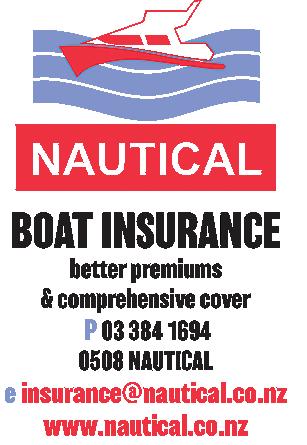






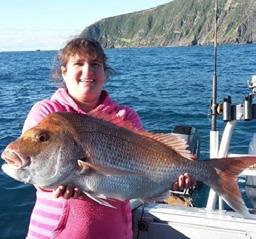
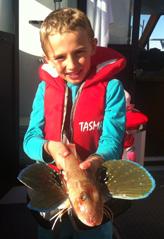
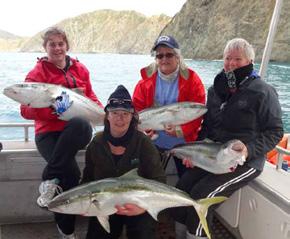





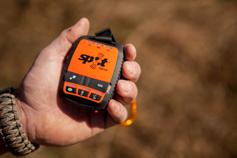
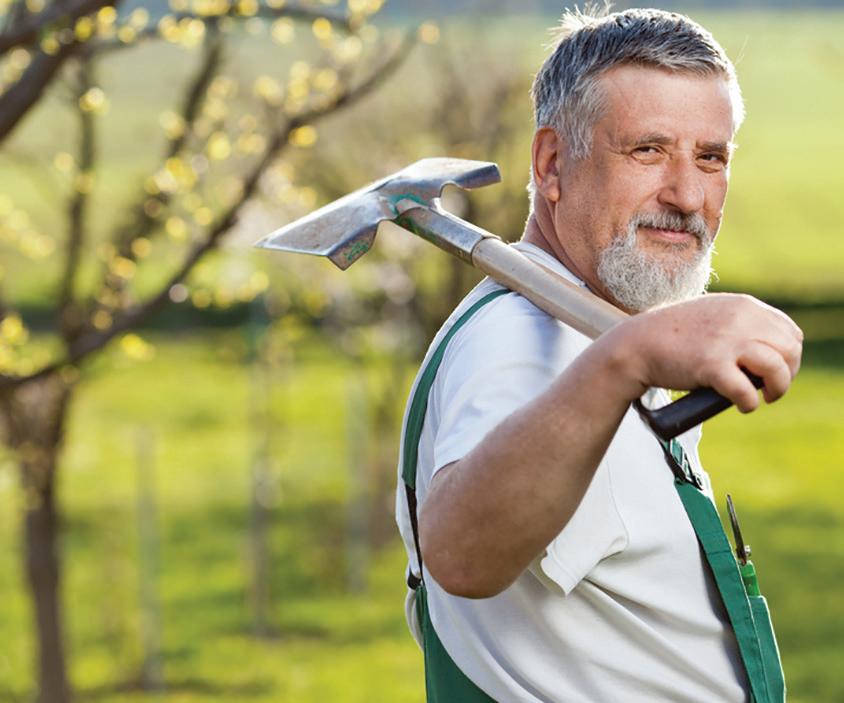


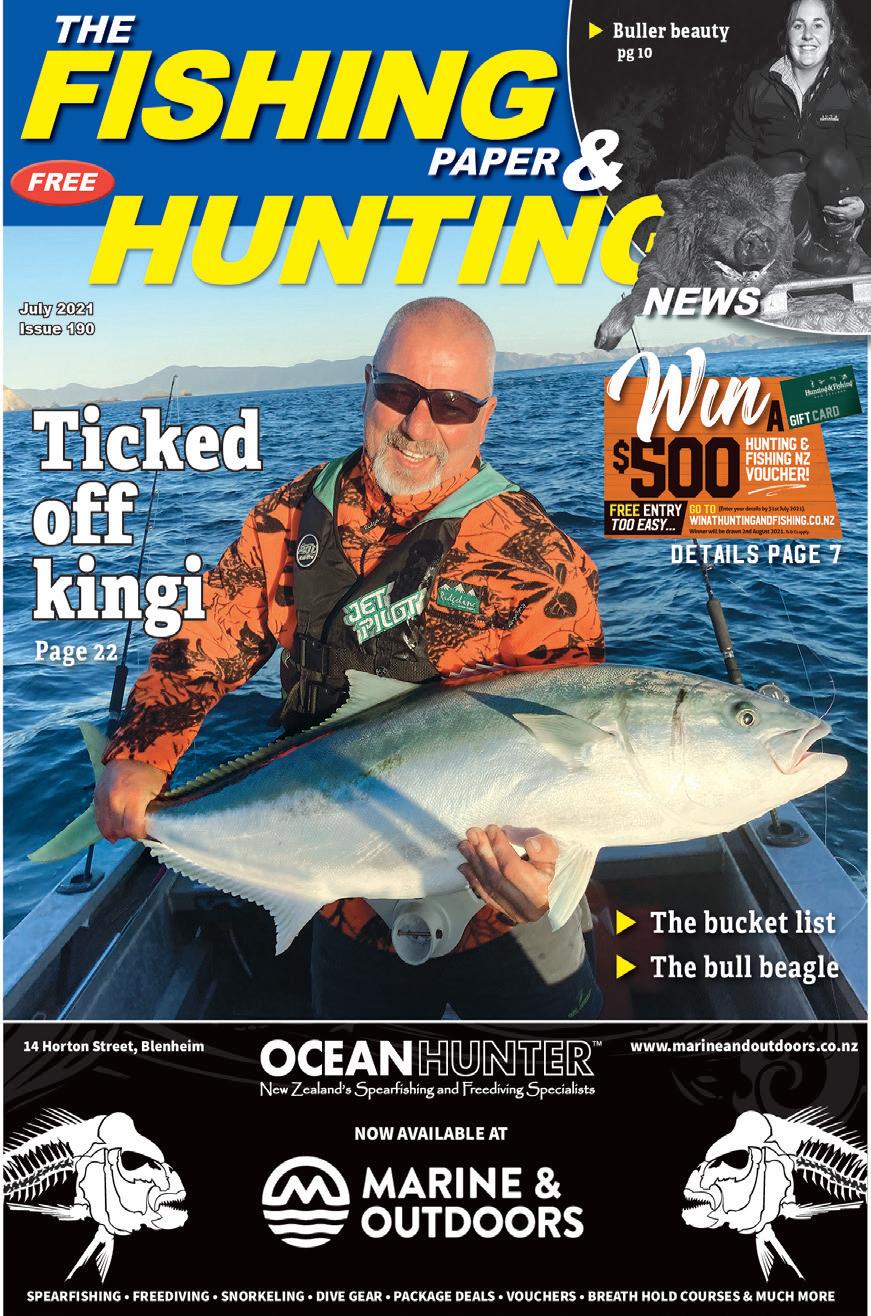
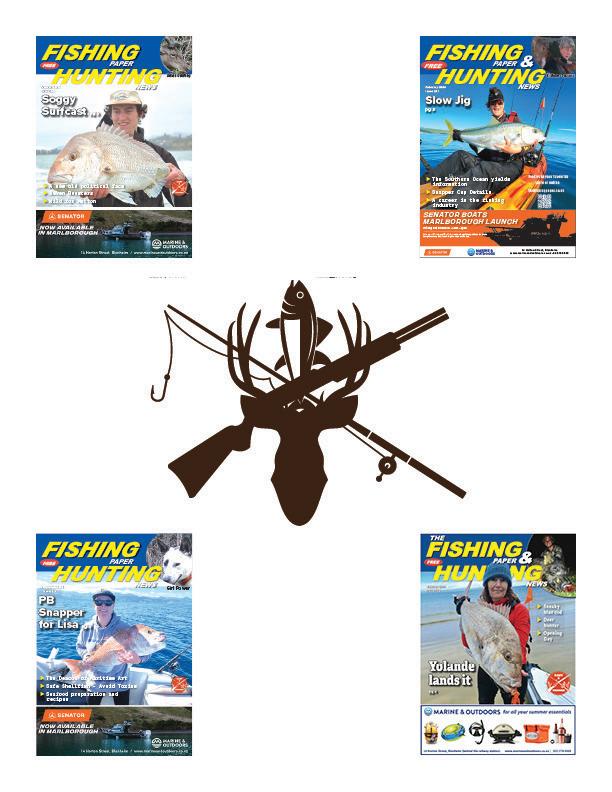
Issue 224 FIND US AT THEFISHINGPAPER.CO.NZ AND FOLLOW ON FACEBOOK 13
COMMUNICATION TRACKME Find Me, Save Me Hire, Buy, Lease, or BYOD TrackMe NZ provides you with local connections to a Global community. Buy from us, or any authorised dealer, and connect with our NZ server. We give you direct support from NZ Rescue services, don't put your life in the hands of anyone else. 24/7 TrackMe NZ Response Centre. All GARMIN, SPOT, DeLorme or Iridium devices Always safe, Anywhere, Anytime, 0800 776 869 - www.trackme.nz TRACKME Find Me, Save Me Always safe, Anywhere, Anytime 0800 776 869 - www.trackme.nz www.dawnbreakers.co.nz Join Online open day 25.09.2016 3-5pm City Club / Maitai Bowling Club, 1 Kinzett Tce swing by for a chat and nd out what our club is all about... family friendly activities big annual competition and prize giving organised shing trips monthly events, social meetings, prizes and shing updates New season starting 1. October 2016 Sign up in September and be in to win a $100 BigBlue voucher! Become a part of our fishing community JOIN TODAY • Family friendly activities • Big annual competition and prize giving • Organised fishing trips
Monthly events, social meetings prizes and fishing updates FISHING CHARTER KAIKOURA
THE DIRECTORY
•
SPECTACULAR,
Email:
Let us fix your plumbing problem so you have more time for fishing. PLUMBING Helping you make time for the good things in life... 59 Saxton Rd, Stoke, Nelson Ph 03 547 4777 Fax 03 547 6208 www.stokegl.co.nz OPEN 7 DAYS Courtesy Trailers Available GARDENING
843 908
info@topcatchcharters.co.nz
Services
x Drone
• Rippon Shark
Drone
Aeroo
• Demos
Drone
Tutorials
Surfcasting Tutorials
Guided
Fishing Trips
Prices on application
South Island Contact us on 022 540 8187 waynegillard66@gmail.com Wayne and Tash DRONE FISHING GET NOTICED INSURANCE Promote your business or product to our readers Call us now to find out how! 03 544 7020 or email: admin@thefishingpaper.co.nz We want your stories please - both hunting and fishing tales. You don’t need to be great with words, just send through the basic details and a couple of decent photos. Please send to editor@thefishingpaper.co.nz
The Mainland Catch app is ready for use in the South Island Fish Mainland Inc. is pleased to advise you that the Mainland Catch app has been approved for release on Google Play for Android devices and on the Apple App Store for iOS devices.
Marine recreational fishers throughout the South Island can now self-record data on their catch, effort and catch location.
The app records GPS location, date, time, fish species, fish size, fish numbers and photos. Fishers’ collective data can be used to broadly signal localised trends in abundance, size distribution and availability of species.
The benefit for fishers is knowing that their data is aiding the management of fisheries that are important to them, including substantiating the importance of a fishery for recreational use and preferred fishing grounds.
Mainland Catch App - Download Now !
Randall Bess
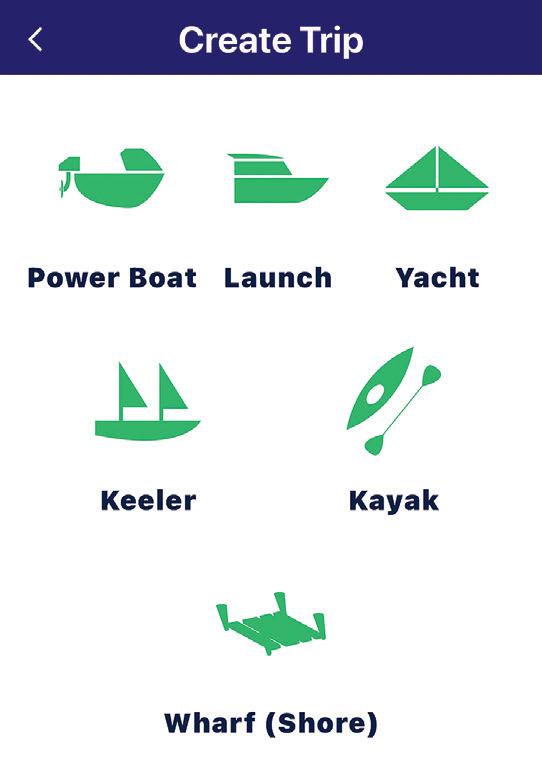
In other words, the data provided through the app can strengthen fishers’ positions on important fisheries management decisions; far more importance is placed on data than mere opinions.
Furthermore, South Island fishers can be involved in fisheries management changes that are starting to occur worldwide. These changes start with governments acknowledging the relevance and importance of recreational fisheries and the need for better governance and management.

The first step toward improving management is collecting better data on recreational catch, effort, and catch location.
Fish Mainland is encouraged by the Minister of Oceans and Fisheries, Hon. Shane Jones, asserting that he is pleased with developing the Mainland Catch app as part of our collaborative and innovative approach towards managing fisheries.
The Mainland Catch app is free of charge; its use does not require Fish Mainland
membership, though app users are encouraged to become members.
Apps of all sorts require users to first register. For the Mainland Catch app, users must register to:
• Receive app updates.
• Receive data upon request.
• Restore data should the app user change phones (but keep the same phone number).
Registration is also required so that Fish Mainland can:
• Verify the data if there are doubts about data accuracy, reliability, etc.
• Use the data for fisheries management research purposes ONLY, not for any advertising purposes.
• Help inform Search & Rescue of the app user’s
location if any safety issues arise.
Fishers’ data will be available as a personal diary. Data will be confidential and not made available to the public unless the app is used in a fishing competition.
Data will only be available to the public and Fisheries New Zealand in aggregated form (e.g., reporting area, region). The data collected will be securely stored in the Microsoft Cloud.
Before receiving Google and Apple approval, Datacom, the app’s developer, undertook rigorous internal testing procedures to ensure the app works as intended and to accommodate testers’ feedback. This feedback led to several improvements that have made the app users’ experiences more accessible and intuitive.
Also, testers sent data from throughout the
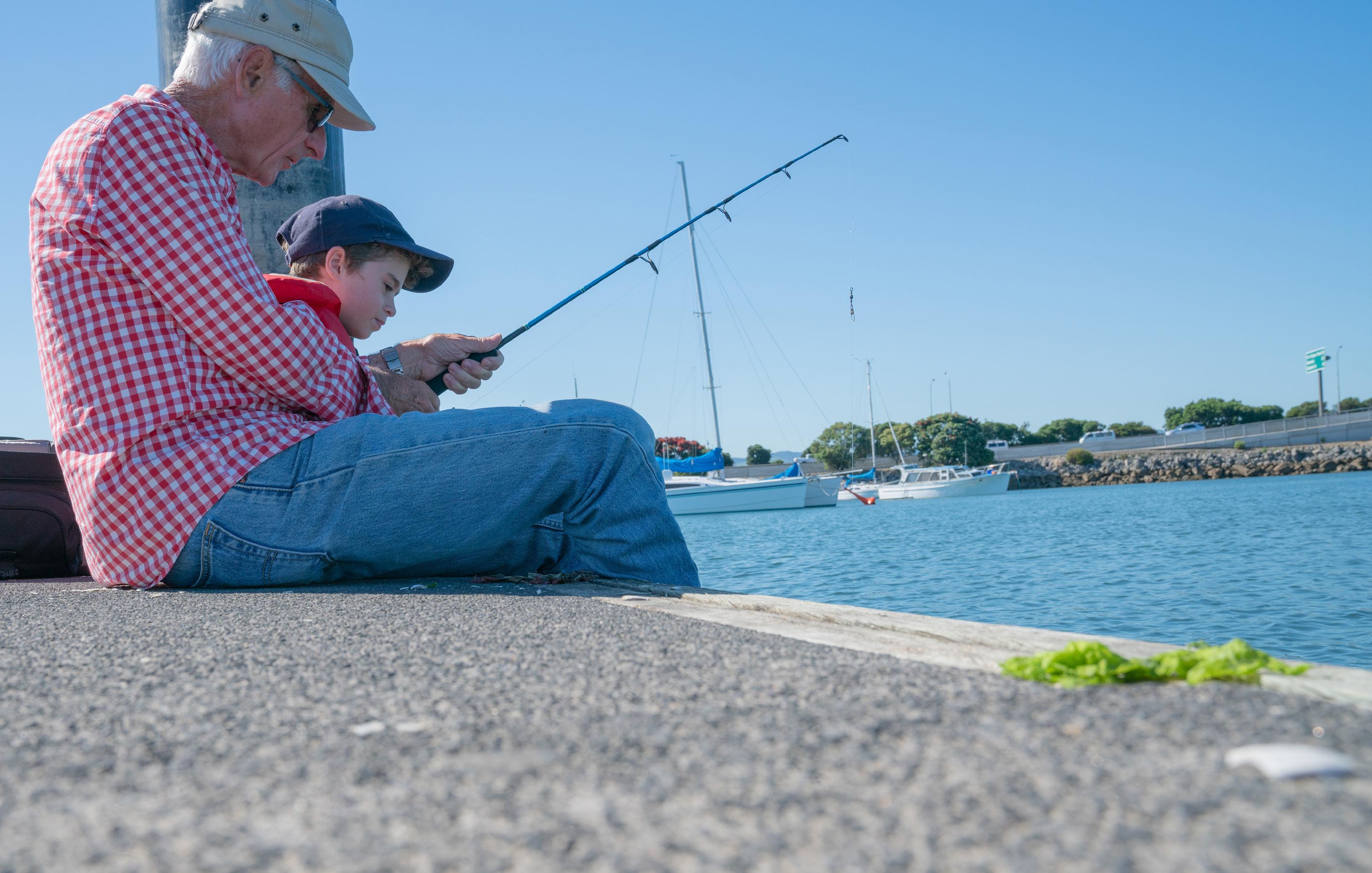
South Island, including remote locations along the Kaikoura coastline where the public can access paua during the PAU3A opening (22 April to 21 June).
Fish Mainland encourages fishers participating in the PAU3A fishery to record their data, as it will be invaluable for improving the management of this iconic fishery.
The Mainland Catch app is possible only because of the financial support provided by MPI’s Sustainable Food & Fibre Futures and the Myers Foundation Trust.
Instructions for registration, app downloading, and videos on the easyto-use app are at this link: https://www. fishmainland.nz/ mainland-catch-app. Should you encounter any problems when registering or downloading the app, please contact info@ fishmainland.nz
Have you downloaded the Mainland Catch App?
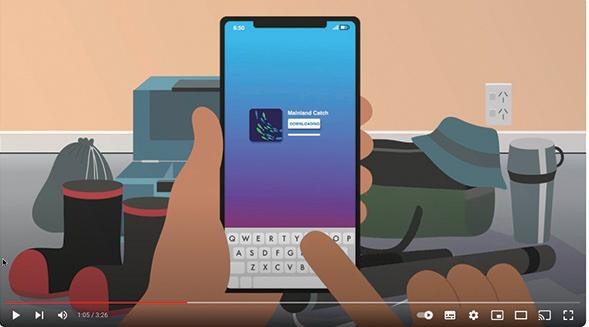

14 THE FISHING PAPER & HUNTING NEWS - MAY 2024 FIND US AT THEFISHINGPAPER.CO.NZ AND FOLLOW ON FACEBOOK
SCAN HERE TO DOWNLOAD OR TO LEARN MORE
PongaRoar 2024 - Pongaroa’s Annual Hunting Competition
Every year at Easter, the sleepy rural village of Pongaroa comes alive with the annual ‘PongaROAR’ Easter Hunting Competition, raising funds for the Grassroots Rescue Helicopter - a service we are very grateful for out here.
This Easter seemed to be one that gave us a few challenges – with Easter falling early in late March and a lack of cool mornings, any roar had not properly started. Topped with the very dry conditions, the pigs were even more challenging for the dogs to find. We had rain, we had wind, and we had one beautiful clear night with the stars out, which led to a gorgeous morning - an ideal dew on the ground, clear skies showing signs of a beaut day> Yet no pigs , so it’s safe to say, for the locals at least, some serious efforts were required to make an appearance with an animal at the weigh-in! Thankfully, come weigh-in time on Sunday at the Pongaroa Hotel, the weather behaved, and no tents or raincoats were needed. Even the notorious Pongaroa wind stayed away!
This year, the PongaRoar received the most entries we
have ever had, with over 330 people entering - the kid’s section where rabbits, hares and turkeys are gathered, right through to juniors, Women’s, and Open.
The team’s event‘The Roar 4’ - teams of up to 6 hunters, must weigh a Red, Fallow, boar and goat head.
Sunday saw all these people arrive with trailers and ute decks loaded to the brim! With the deer still in pretty good condition, the animal weights were impressive, with the heaviest red being over 160kg, and the fallow, a whopping 78kg - 77kg, was the heaviest boar. Not to be outdone, the kids arrived in their masses with almost more animals than the trailer could cope with! The heaviest turkey was a massive 8kg! I’m sure there are some very happy farmers out there with all those pests gone.
We had our usual Kids Pig Carry competition, where we set up an obstacle course. The quickest time, carrying the pig, wins. They must weave through the scrub, push through vines, climb over bales of hay, and lastly, get across the pool full of water without falling over. We have four
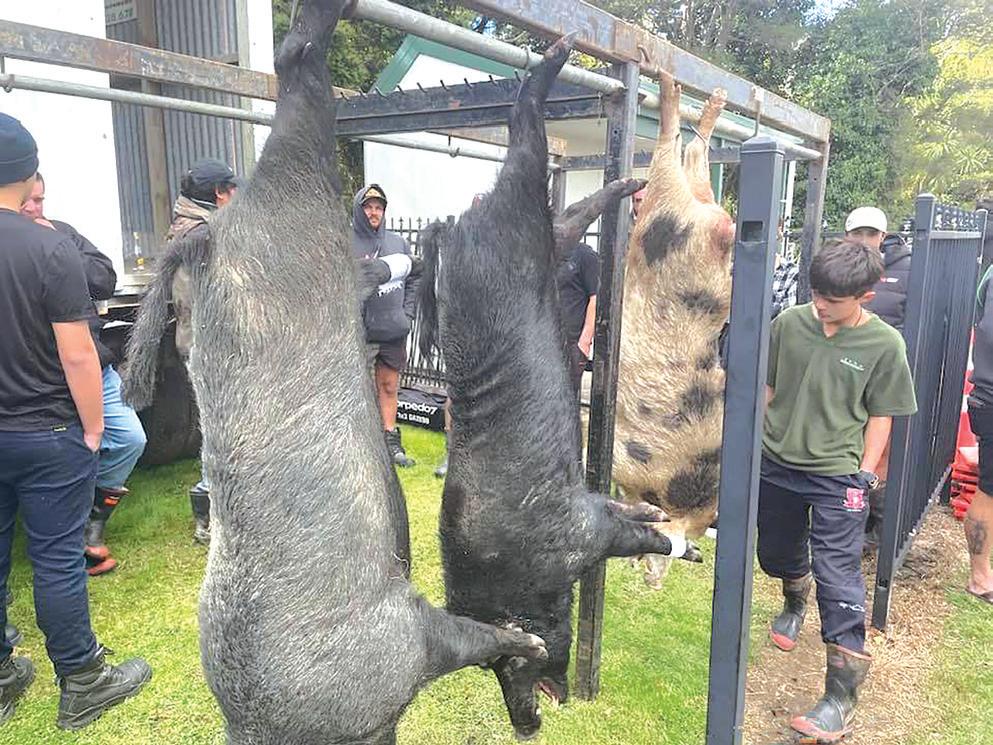

different age groups, and the younger kids are welcome to carry a rabbit or hare around the course. Competitors were putting in an extra effort here this year, with the TV crew from Kea Kids News making an appearance. They did a fantastic job showing our part of the country - how we can make something
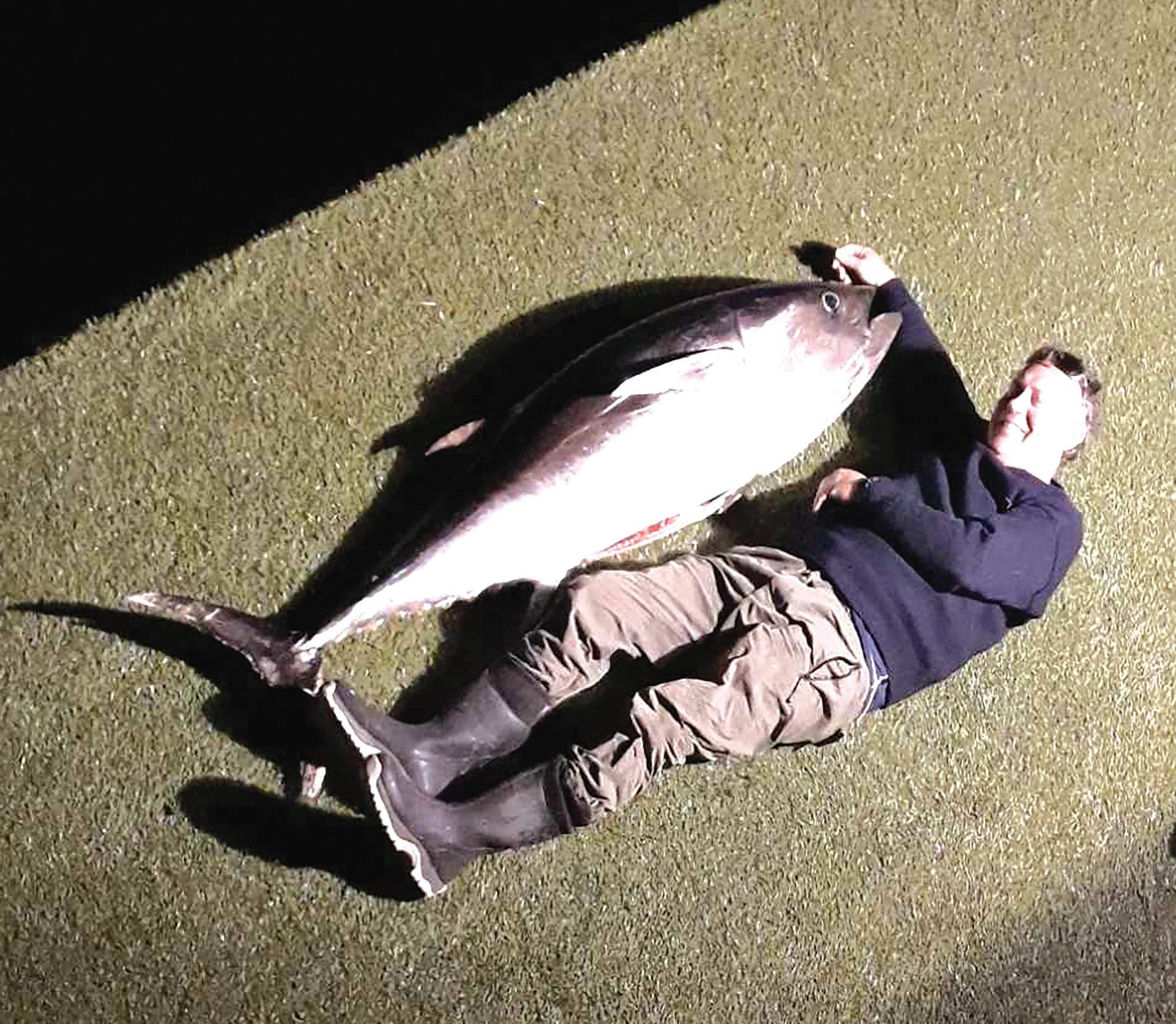

was a very happy man to win this, and so was his son, judging by the hands holding onto the box after they received their prize.
like hunting a great community event, raise funds for the Grassroots Rescue Helicopter, and put food on the table. Everyone had decided to stick around for prize giving. With the help of Wairarapa Hunting and Fishing, we were able to give away a monocular thermal—its value is a huge $1,400. Hamish

Proud editor moment - the S J Seahawk was launched a few weeks ago . A very successful trip out to Cook Strait last weekend and a very tasty tuna.
The June edition will feature the S J Seahawk project.
The new publican, Keith, and his team did a remarkable job keeping us all fed and watered - we are incredibly fortunate to have such a dedicated group supporting us and our fundraising cause. All of our sponsors, including Wairarapa Hunting and Fishing, went above and beyond this year. We had cube rolls to auction off, vouchers for Taxidermy, a Rugged Valley voucher, and a bunch of Bean Bags from Big Save Furniture, among other generous contributions. Sponsors play a crucial role in events like this, and despite the challenging
economic conditions , their generosity was overwhelming, and we are truly grateful. This year, we are able to donate a substantial $6,000 to the Grassroots Trust Rescue Helicopter. It makes all that effort and organising so worth while when it goes to such a great cause . We are so very lucky to have them come and “save the day” out here! A big shout-out to the PongaRoar committee. You guys are a really wonderful bunch of people, and it wouldn’t be the same without you. Well done, team! We look forward to Easter 2025 - you can follow us on Facebook, ‘The PongaRoar’.

Issue 224 FIND US AT THEFISHINGPAPER.CO.NZ AND FOLLOW ON FACEBOOK 15
Abbey Mager Club President
Sweeping Changes To Fishing Rules For The Fiordland Marine Area
The Fiordland Marine Guardians have welcomed widespread changes to the area’s recreational fishing rules, which came into effect on April 25th. The new rules are one of the outcomes of a review that the Guardians led on the sustainability of fisheries in the fiords.
The review began in 2019, prompted by growing concern from the community that key fish stocks (including rāwaru/blue cod, hāpuku/groper, pāua and scallops) were in trouble. The Guardians have advocated strongly for the changes and have been working with the community for several years to define the problems and develop solutions.
In New Zealand, whilst there are established allocations for recreational take of fished species (tonnes per year), there is no effective way of monitoring actual take relative to these allocations. In other words, the total take of a species by recreational fishers can’t be capped. In contrast, commercial fishing is set to a Total
Allowable Commercial Catch (TACC), and take is measured to ensure the TACC is not exceeded.
The challenge with managing recreational fishing under these circumstances is that regardless of the daily recreational limits, the more boats and fishers you add to the mix, the higher the total recreational take. Even with conservative bag and species limits, there comes a time where the total recreational harvest is no longer sustainable. The signs that fish stocks in the fiords are declining indicate that the current level of fishing pressure is too high.
With a lack of hard data it is impossible to state exactly how poor the fishing has become in the fiords. Those who are relatively new to the area might be impressed by the large pāua and blue cod you can find if you look for them. Those a little longer in the tooth reminisce about the days when they could catch groper in the fiords with ease and be so confident in catching blue cod for dinner that they

wouldn’t take any meat in with them. And it’s that baseline that the Guardians want to return to. This isn’t simply a case of holding the line. In several instances, fish stocks need to be rebuilt, and the only way to achieve that is to significantly reduce the overall level of fishing pressure in the fiords. The fiords are a predominantly recreational fishery, as commercial fishing is excluded from the internal waters and, with the exception
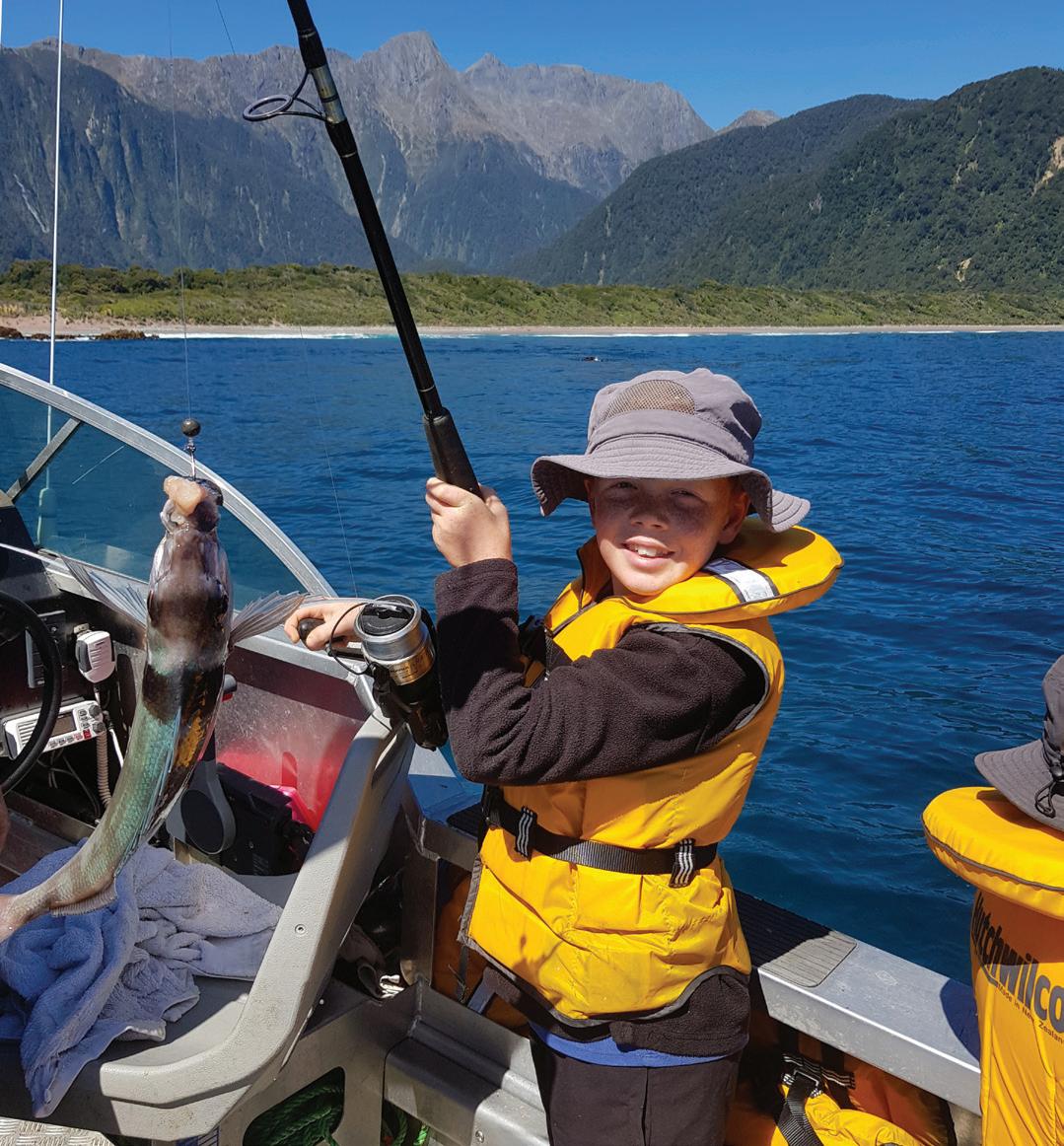
of rock lobster, the majority of commercial fishing takes place on the open coast.
The new rules are designed to encourage people to fish in places that can support a higher level of fishing effort. There are higher bag limits for finfish on the open coast (20 per fisher) than inside the fiords (10 per fisher). These limits reflect the fact that stocks on the open coast are more productive than those inside the fiords, where lower amounts of sunlight, wave energy
Let’s look after this incredible place so future generations can enjoy it too
We encourage you to fish for a feed, not for the freezer.
As a group, we’re responsible for managing and caring for Fiordland’s precious marine environment. Before you set off, make sure you know the “where, what and how” about fishing in Fiordland. Clean your vessel and gear so you don’t take any unwanted visitors with you.
Connect with us at FMG.org.nz
and higher freshwater cause fish to grow and breed at slower rates.
The daily limits for individual species of finfish and shellfish have been reduced across-the-board. In many cases, limits for individual species are higher on the open coast than inside the fiords. For example, on the open coast the daily limit for blue cod is 10, compared to a limit of 1 inside the fiords. Similarly, the daily limit for pāua is 5 on the open coast and 2 inside the fiords.
The main changes are:
• Reductions in mixed bag and single species limits for most species of shellfish and finfish
• Establishing a new zone called “the Fiords” within each fiord, that begins at a boundary across the entrance headlands of each fiord
• Tiered mixed bag and single species limits (lower in the Fiords) to incentivise fishing in the more productive open coast areas
• Closure of scallop and oyster fisheries throughout the Fiordland Marine Area
• Closure of hāpuku/groper/ bass fishing in the innermost parts (Internal Waters) of all fiords
• Rock lobster limits have not changed
The Guardians’ review of fisheries sustainability has also caused the Minister of Fisheries to consider introducing restrictions on fishing methods in the fiords (recreational and commercial) and changing legislation to enable daily recreational limits to be imposed on vessels. Vessel limits could be an effective way of preventing localized depletion of stocks, particularly in vulnerable areas such as the inner fiords.
The biggest lesson that we have learned is that we need robust data to inform the management of these fisheries in a timely manner. In the fiords we are trying to manage a largely recreational fishery, without any data about the effort and catch from fishers that use private vessels. We are therefore very pleased that Fish Mainland has developed the Mainland Catch app. If the fishing community gets onboard and reports their catch, we will be in a strong position to review these rules in five years’ time.
16 THE FISHING PAPER & HUNTING NEWS - MAY 2024 FIND US AT THEFISHINGPAPER.CO.NZ AND FOLLOW ON FACEBOOK
Scan to go direct to website
Rebecca McLeod , Chairperson of the Fiordland Marine Guardians
Photo courtesy of Jon Clow, Guardian
Photo Credit : Dirty South Dive
Catch Limit Changes for Fiordland and Chathams
Recreational fishers heading to Fiordland and the Chatham Islands will need to check the new catch limits that came into force on 25 April.
Daily bag limits for a range of recreationally caught fish species in these areas have reduced, as has the nationwide daily limit for quinnat salmon.
“The changes are to help keep our fisheries healthy and sustainable, so that current and future generations of fishers can continue to enjoy local kaimoana”, says Emma Taylor, Director Fisheries Management, Fisheries New Zealand.
“These are both unique areas of Aotearoa that have experienced an uptick in visitors in recent years, many of which are also keen fishers wanting to catch a feed of some of our most iconic fish species".
have been driven by concerns from tangata whenua and community groups about the long-term sustainability of several fish species. With additional fishing pressure in these areas, locals were worried that their fisheries would suffer if the catch limits stayed the same.
“In Fiordland, some fish stocks are more productive in the waters outside of the fiords and the changes will help move fishing pressure to the areas where it can be better sustained. For example, the daily limit for Hāpuku/Bass has dropped to one fish per person in the fiords waters, and five per person in the more productive areas of the Fiordland Marine Area (outside the fiord coastal waters)".
Changes for Fiordland include:
• Reductions in daily and
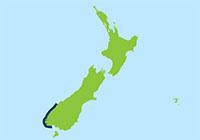
limits within the fiords, particularly for resident species such as blue cod, hāpuku/ bass, and pāua.
• Shifting the boundary line for the area where there are daily lower limits for some species in the internal waters of Fiordland further out to the fiord headlands.
• Smaller reductions to daily limits in the wider Fiordland Marine Area to ensure sustainability of the fisheries that may be subject to a resulting shift in


The full list of changes can be found on MPI’s website: fisheries.govt.nz/ fiordland-fishing-rules “The proposals for Fiordland were developed by the Fiordland Marine Guardians and went through extensive public engagement, with the Guardians providing expert advice throughout the process,” says Ms Taylor.
The Chatham Islands is another unique part of New Zealand and has become a popular destination for people from around the country and beyond to visit and catch some
sought-after kaimoana. It’s an area that is well known for its pāua, rock lobster, hāpuku, blue cod and many other popular fish. To better understand the level of recreational fishing activity, the local community developed the idea of a survey to gather details about recreational take of popular fish species and what they thought the limits should be. To further support this, Fisheries New Zealand proposed to remove the accumulation limit to encourage people to ‘fish for a feed’, rather than for the freezer.
“It really has been great work from the community, alongside Fisheries New Zealand, to support their desire to sustainably manage their local fisheries,” Emma Taylor said. Changes for the Chatham Islands include: Reductions to the
species, including blue cod, hāpuku/bass, kingfish, and pāua.
Removing the ability for recreational fishers to accumulate multiple days of catch on the islands (as previously announced in 2023).
The full list of changes can be found on MPI's website: fisheries.govt.nz/ chatham-fishing-rules
In addition, the nationwide catch limit for quinnat salmon caught in marine waters has reduced to one fish per person per day. This aligns the catch limit for marine caught salmon with the limit that applies for rivers and freshwater administered by Fish and Game New Zealand.
Options for the various changes were publicly consulted, and the majority of feedback received supported these changes and reflected

Issue 224 FIND US AT THEFISHINGPAPER.CO.NZ AND FOLLOW ON FACEBOOK 17
CHECK THE RULES YOU GO OUT BEFORE FOR YOUR AREA FISHING fisheries.govt.nz/rules Download the NZ Fishing Rules app. Free text the name of the fish you’re catching to 9889.
Fiordland Marine Area and Chatham Rise Fishing Area
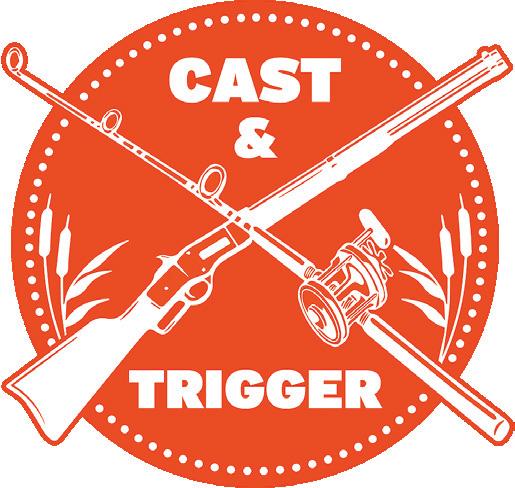


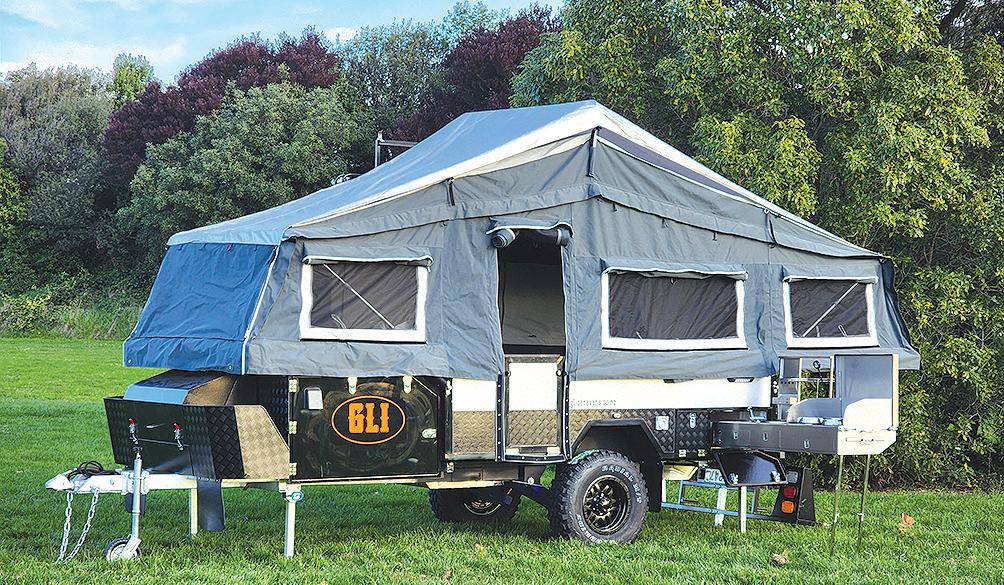


The Whanganui Pistol Club had set up 12 stages or courses of fire for the weekend with eight stages on Saturday and four stages on Sunday.





They have been running this competition for a long time and I would hate to think how many times I have gone up there to compete.
My club had a good group travel up and we were shooting a lot of different divisions, which are based on the style of pistols used and what we have added to them in the way of sights or compensators. These can be as serious as you want, some are all out for the win while others knowing they can’t win the overall
title, go for their grade wins. Or if you are over 50, 60 or 70 then there are age groups, not that the competitions change just more noise from the joints when we bend and try to run. As it is a family sport, there are a few that have to bring their dad’s along to keep an eye on them. I wouldn’t want to name anyone (Ryan and Rachel) but it was good to see that Paul did a good job!
The Whanganui Pistol Club has a very good set up, nice green grass all over the place which is a pleasant change from my club which is all crushed rock and as hard as hell. They do have a little problem with iron-sand that is everywhere, and that stuff sticks to everything, especially the magnets some of us have as mag pouches. This can also be a problem after we drop mags during the reload, because unlike
most movie guns ours do run dry. Being consistent is all important at these competitions. Some of that comes from the competitor and some on the gear they use, which to be fair is the competitor’s problem as it is our job to make sure everything runs smooth. By that I mean the firearm works perfectly, it doesn’t jam or miss fire in anyway, which in a lot of cases can be an ammunition issue.
The weather was great and it all ran like clockwork, as the stages were set up so that they would run without a hitch. Not a single penalty target to be seen which was good because I have a habit of getting a few, which can cost me a lot of points as has happened in the past. All up a good shoot and a great weekend was had by all. Thanks Whanganui Pistol Club.
There is a south island tourist location which is well known for its seafood delights. Scattered through the town are several cafes and restaurants and each seems to have its own specialty on any given day. Tourists and locals frequent such establishments and during the holiday periods in particular it is clear to any observer that business is generally pretty good.
Good seafood is not inexpensive – it must be fresh, it must be carefully prepared and cooked and it should be presented well. For all of that effort and for the deliciousness of the final product a customer will gladly part with some serious money. And of course,
there are businesses willing to make the most of that.
But not all of them do it the right way. What follows is a true story for which I still don’t have the final ending, but to get you up to speed I will explain the first few chapters.
Good mate of mine shouts his son a trip down south with his new girlfriend and recommends our particular tourist town as a destination. Son and the girlfriend choose a café for lunch and he orders the alleged freshly cooked lobster off the menu. For your money you get half a lobster with some salad, chips and a choice of dressing. Lobster is served and with joy in his heart and soon in his
stomach the lad starts picking sweet white meat from the tail. Then notices a cluster of berries – or lobster eggs – on two of the tail segments. He calls to the proprietor - Hang on mate, you can’t keep lobsters with eggs on and you sure as hell can’t sell them with eggs on.
The seemingly abject apology from the café owner went something like this – Very, very sorry I don’t know how that happened – we always scrub the eggs off before we cook them, we must have missed one. I will get you one with no eggs. The next chapter will eventually play out when Fisheries Officers investigate the complaint (complete with photos) and pay
a visit to the offending café.
As you might have guessed by now I have been on god’s earth for quite a while so nothing really shocks or surprises me. And at my age I well remember the Galloping Gourmet, Graham Kerr – who by the way was a pioneer in the paua industry around Wellington in his younger days. In his first published cookbook Kerr provided a recipe for “Coral Butter”, the main ingredient of which was
‘carefully removed eggs from a freshly killed lobster’. But at my age I just cannot remember exactly what the relevant fishing rules were back then – but I certainly know what they are now – total prohibition on possession of egg bearing lobsters. Coral butter has long been off the menu.

18 THE FISHING PAPER & HUNTING NEWS - MAY 2024 FIND US AT THEFISHINGPAPER.CO.NZ AND FOLLOW ON FACEBOOK
www.glio road.co.nz NewWebsite Order now www.glioffroad.co.nz NewWebsite Order now PISTOL SHOOTING Brian Bishop River City Open - IPSC competition Whanganui April 24 knudsen sports & Toyworld 170 Palmerston St, westport - Ph 03 789 6293 WHEN YOU ARE ON THE COAST COME AND SEE US AND WE CAN GET YOU SORTED FISHING - HUNTING - BIKING - CAMPING GEAR FOR EVERYONE! • Fishing tackle and rods • Bike and accessories • Hunting and tramping gear
The Bait Box with Retired Fisherman Norm Hawler "The Overconfident Crook"
At 59 I had still not shot what could be classed as even a half decent red stag. I had plenty of eight pointers and one arguable 12 - eight good points and four bumps! It certainly wasn’t from a lack of trying and over recent years I had honed my gear so that two and three-day trips could be accomplished without carrying too much crap.
I already had two unsuccessful trips into a certain valley, but each trip left me wanting to go back for another look. After a hectic summer of work at Top Catch Charters – Kaikoura, I had a window of opportunity to get away from March 11-13. Perfect, as the stags should still be out feeding up before the roar but still have hard antler.
After a three-hour slog I made it to my camp site and got set up for an early night before a big day hunting the following day. As I had a couple of hours before dark,
Malcolm Halstead
I climbed a leading ridge to glass the surrounding country. Fog made this difficult, but I did get to watch a hind and yearling come out for a feed just before dark. Back to the tent we went, my collie cross, Frankie and me.
An hour and a half before daylight I was up and getting ready with a good breakfast and a hot coffee.
Enough supplies for the day were loaded into my pack and we were off an hour before daylight. Just before daylight we encountered low cloud, which was a real downer as seeing anything was going to be difficult to say the least! I decided to push on and climb higher and was rewarded with the cloud lifting right on daybreak.
A scan of the first head basin with the Pulsar showed up five deer so it was off with the pack to get the binos into action. Disaster, I had left the Leicas back in the tent! After silently berating
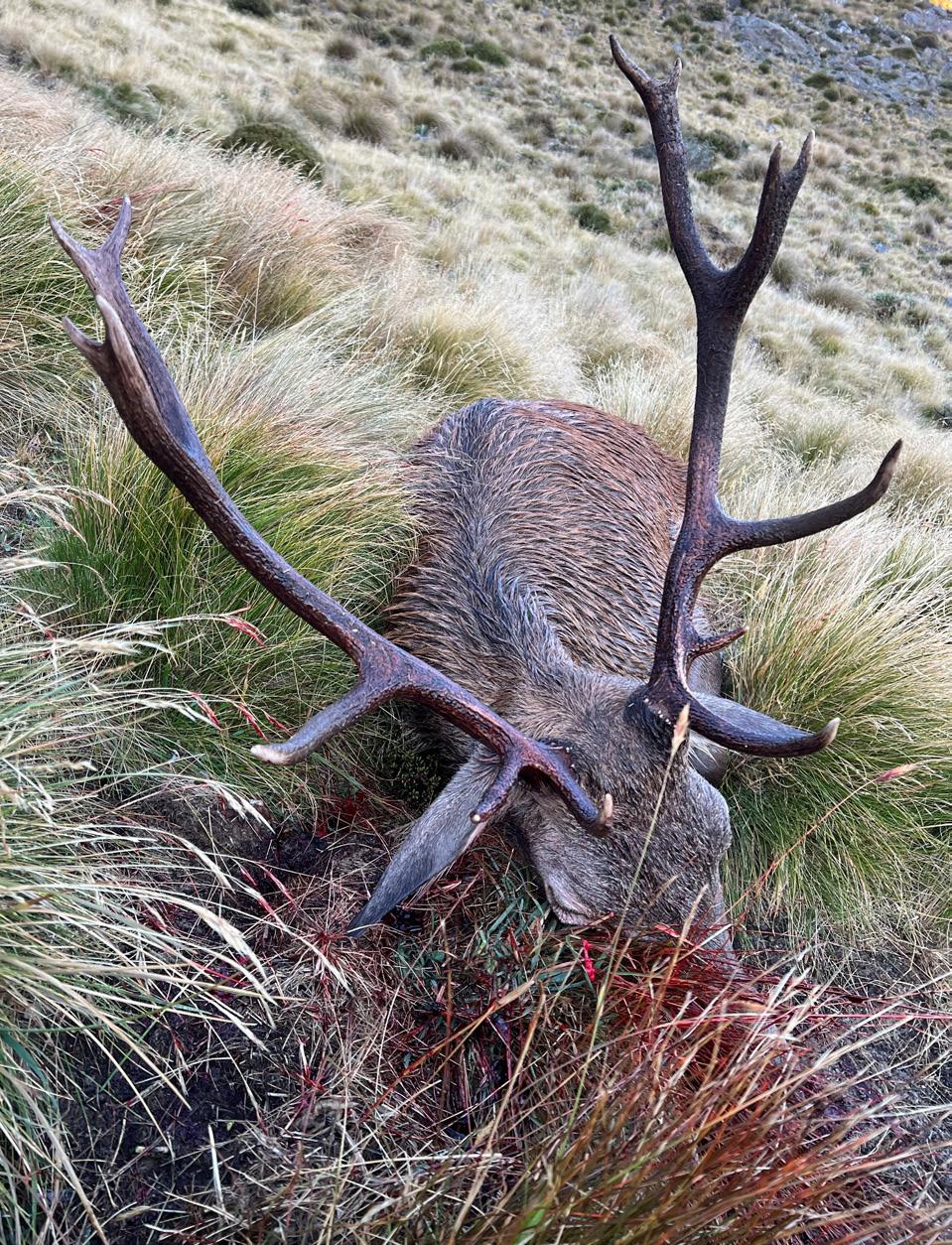
myself for such an amateurish mistake I decided to check the animals out with my scope. This showed four hinds and one lone animal I could not identify. I hatched a plan to stalk in to 200 metres and suss this one out with the scope. I dropped back out of sight and began a slow climb to get within range, while checking out some small gullies on the way.
The first gully was devoid of life as was the second bigger one, so it was time to catch my breath before a final push to a saddle that would give me a good view of the lone animal. As I stood there on the ridge top, I was jolted into life as I spied a stag feeding right out in the snow grass at the head of the gully, only 150 metres from where I stood.
Crouching down I put the bipod on the rifle and wound the scope up to evaluate the head. He looked okay with three on each top, albeit not that strong in length. It was then I noticed two more stags with him which complicated things more. I quickly looked them over and decided they were younger but better quality relative to tine length and shape. One was an eight pointer and the other a 10, so the decision was made to take the first stag. I got Frankie into heel then put a round up the Sako, a pretty easy shot into the chest and down he went. The other two made their way slowly out of the gully and I wished them well for the future hoping to bump into them in a year or two. It was only a five-minute climb to my prize and I was blown away to find he was
in fact a 14 pointer! Not a massive head but very even and everything I could want in a head off public land. I sent a message on my inReach to my partner, Fiona, to let her know what I had done, and I would be home a day earlier than planned. After removing the head and back steaks it was only an hour to get back to camp where I packed up for the walk back to my Hilux.
All up I walked 21 kilometres and climbed over 1000 vertical metres so I sure earned this head. I will also be back into this little bit of paradise to secure another stag in the future.

Growing up as a post war baby boy I was naturally attracted to war comics then true war books, especially prison camp escape stories helped by secret agents and spy networks in mysterious corners of Europe. At a later stage I discovered my father’s ‘war books’ - the cruelty in the Stalags, the cruelty of the Japanese, the German treatment of the Jews, and the bravery of our allied secret agents hidden throughout Europe.
Amazingly, having satisfied my craving for this genre I found myself reading very little about WW2 for
the next 50 years until recently I came across a couple of SAS (Special Air Service) paperbacks. Here I found myself learning so much “real” stuff about WW2 where planning and strategies, tactics and trickery were involved, clever plans devised by divergent thinkers and planners in darkened backrooms, where successful outcomes relied on outsmarting the enemy.
I had just finished the first two of the SAS books and was looking out for a third
when on my doorstep I discovered two new books awaiting reviews. Their arrival proved to be very timely.
“Deceptions of World War 11” by
Peter Darman, and “Secret Heroes of World War 11” by Eric Chaline are marketed as a matching pairboth A5 hardbacks with dustjackets. The contents are extensive - many WW2 photos,

maps and features on key individuals. Among them you’ll find Nancy Wake and the lesser known Alan Turing, also Douglas Bader and many others lesser known with stories the world

needs to know about. These two books make up a wonderful reference resources as well as fascinating historical reading for those families with youngsters growing up wanting to know more about man’s inhumanity to man, and about a very tragic time in our more recent history.
I strongly recommend this pair of books be on hand as a ready reference in every home with children growing up or with ancestors who took part like my father and his brother did.
Issue 224 FIND US AT THEFISHINGPAPER.CO.NZ AND FOLLOW ON FACEBOOK 19
14
At Last
Deceptions of World
11 Peter Darman Secret Heroes of World War 11 Eric Chaline
Book Reviews - Mike Whittall
War

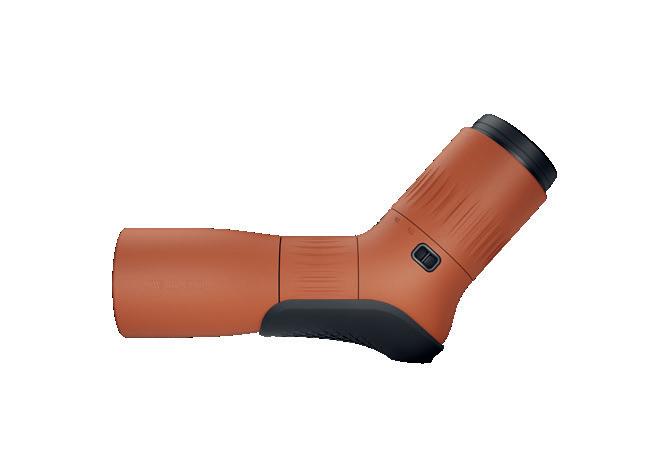
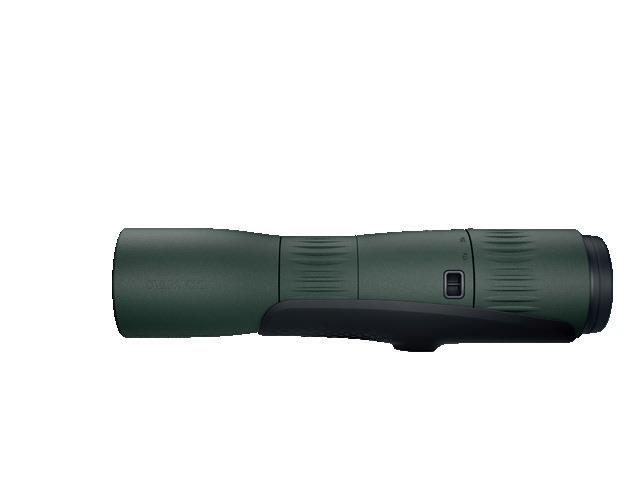
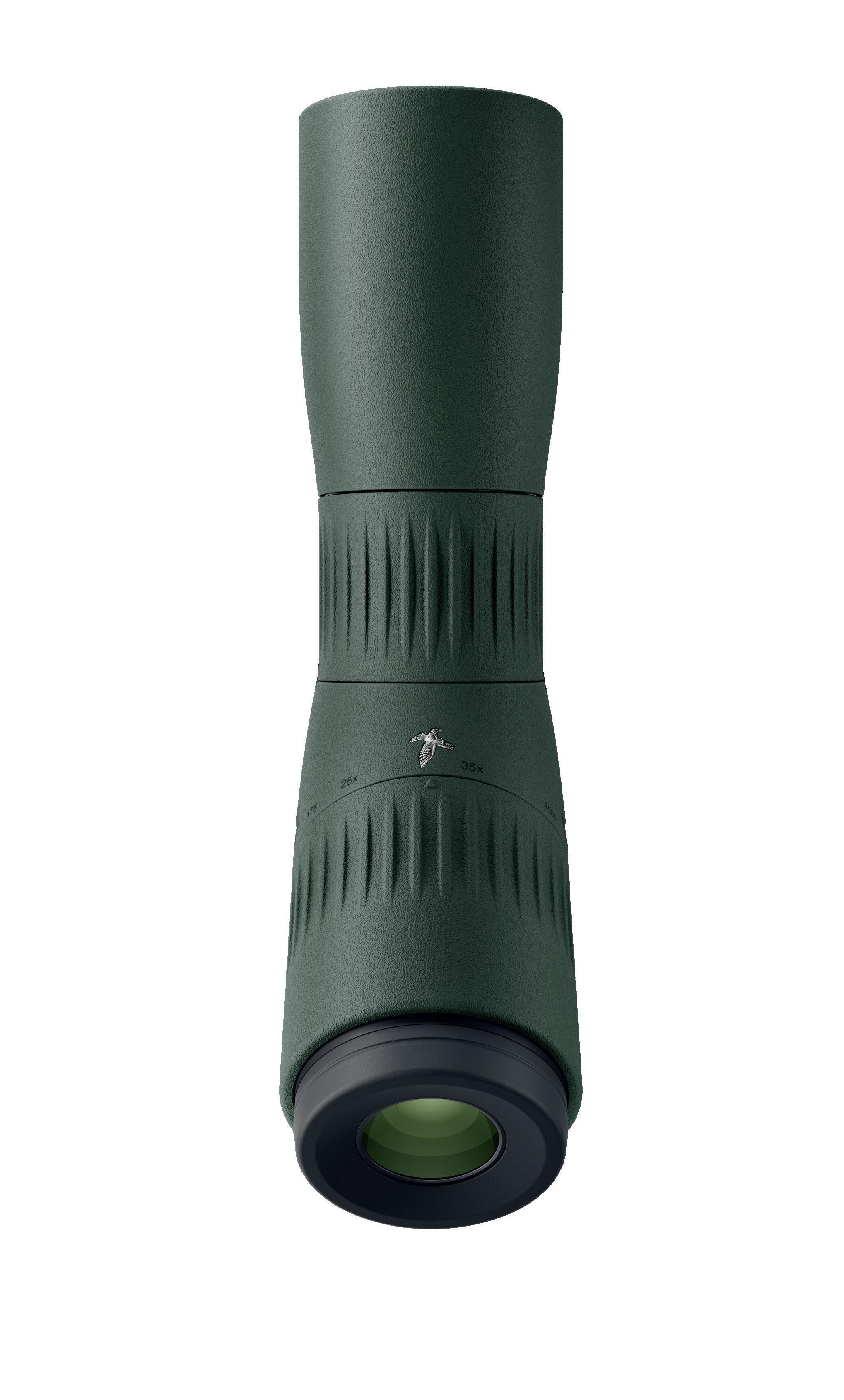
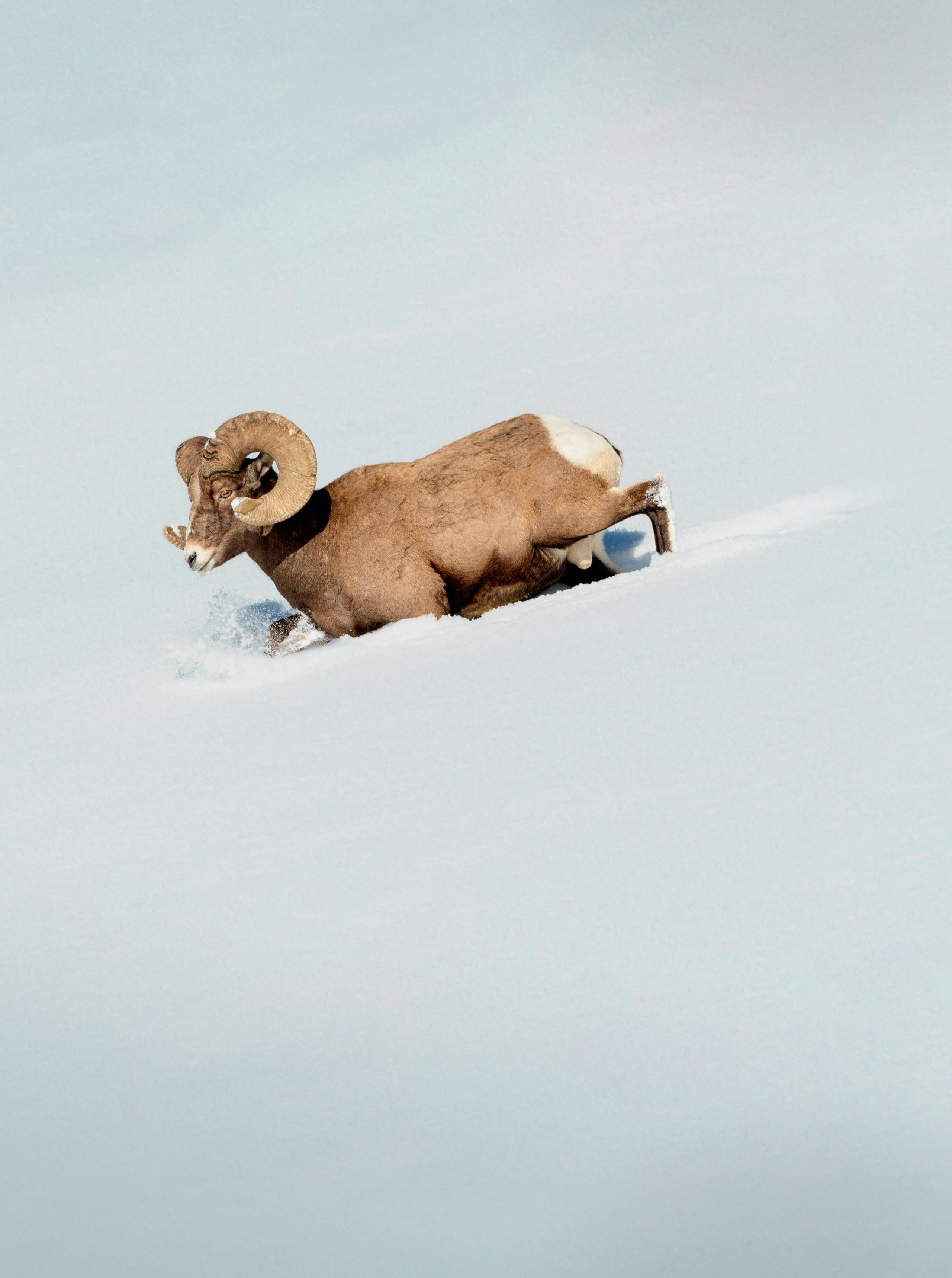
FIND US AT THEFISHINGPAPER.CO.NZ AND FOLLOW ON FACEBOOK SWAROVSKI OPTIK NEW ZEALAND LTD. | TEL. 04-595 4286 | INFO-AUNZ@SWAROVSKIOPTIK.COM | SWAROVSKIOPTIK.COM




































 Angela Govier
Angela Govier








































































































